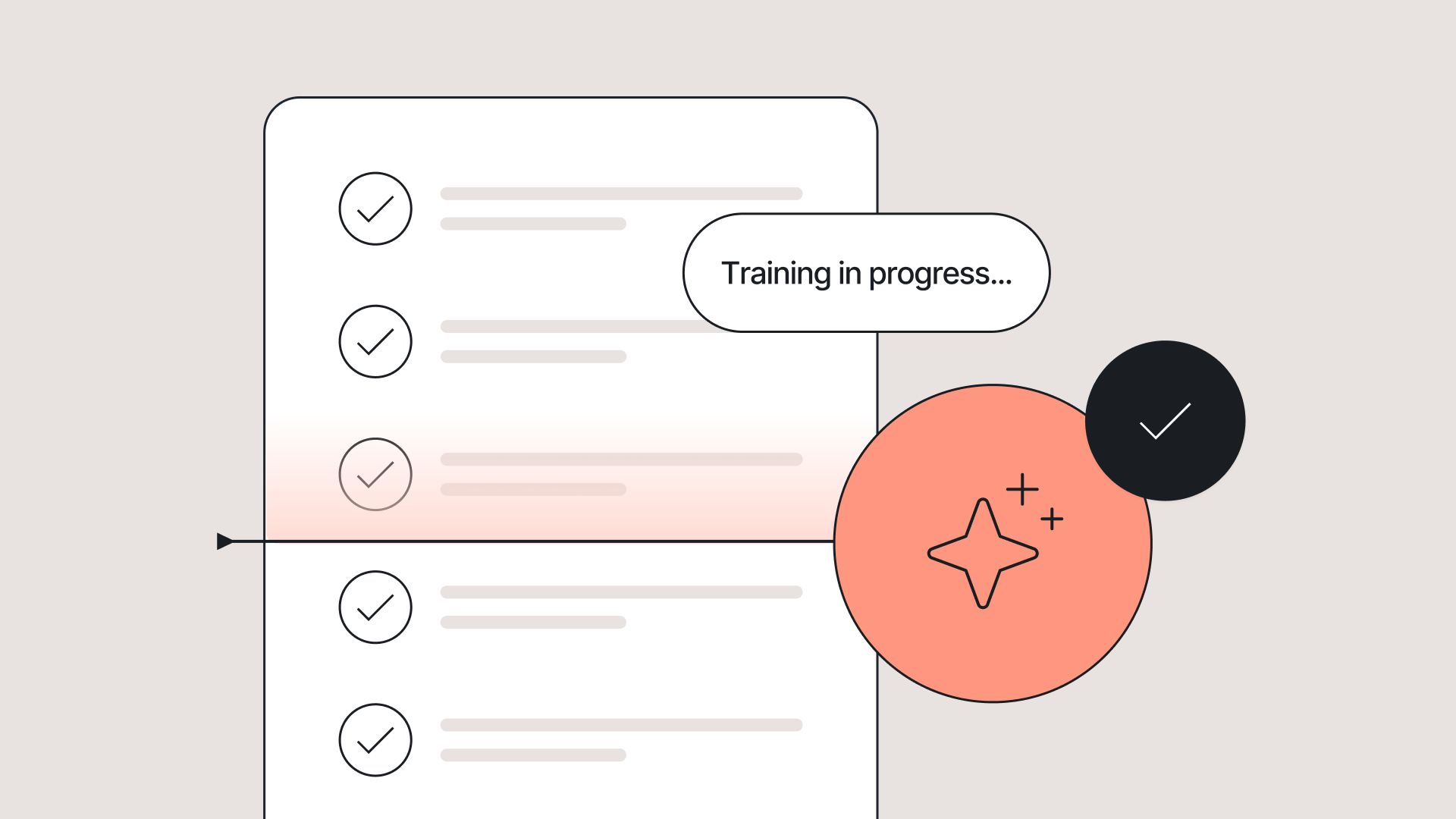
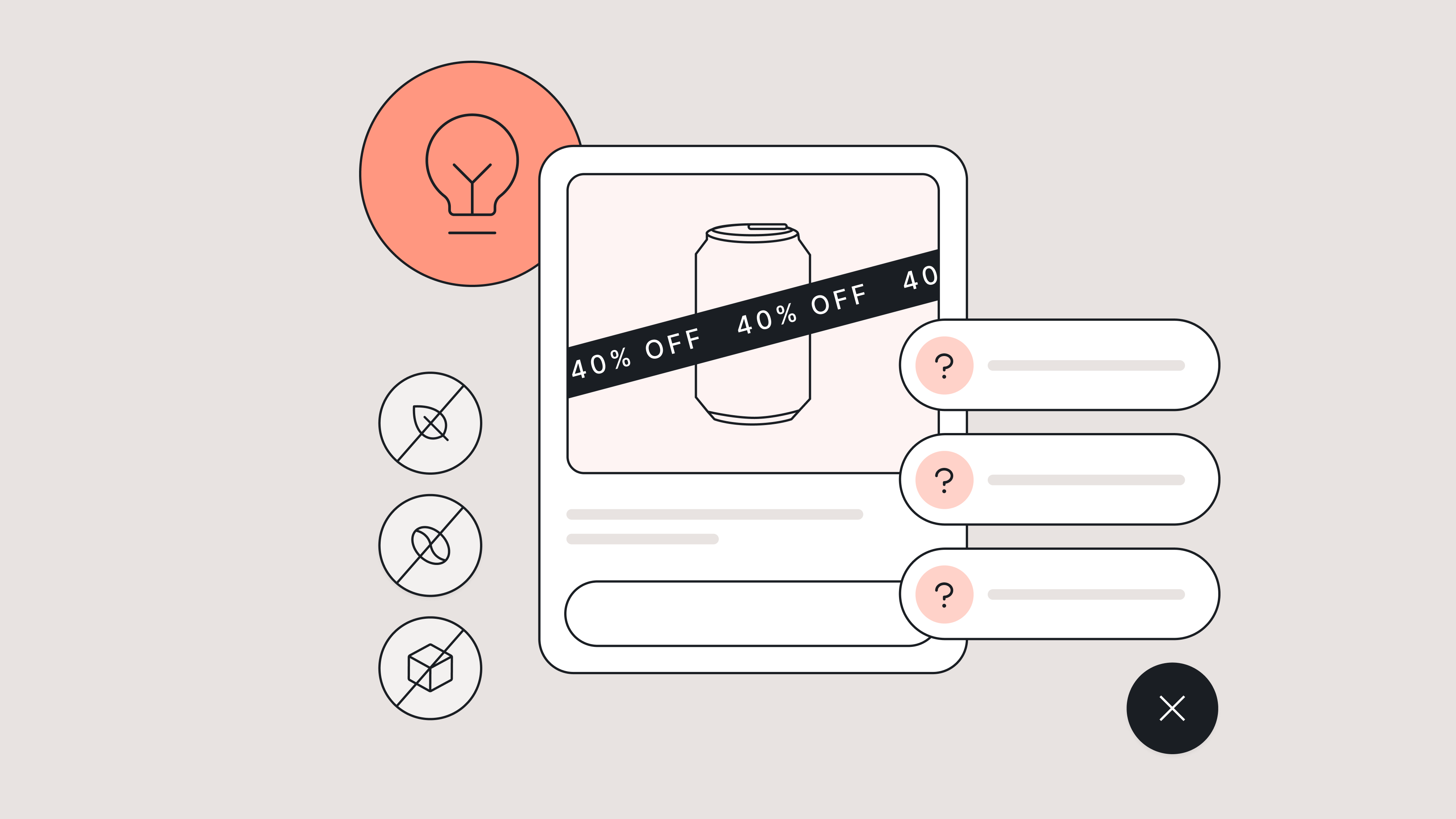

How Food & Beverage Brands Can Level Up Self-Service Before BFCM
TL;DR:
- Most food & beverage support tickets during BFCM are predictable. Subscription cancellations, WISMO, and product questions make up the bulk—so prep answers ahead of time.
- Proactive CX site updates can drastically cut down repetitive tickets. Add ingredient lists, cooking instructions, and clear refund policies to product pages and FAQs.
- FAQ pages should go deep, not just broad. Answer hyper-specific questions like “Will this break my fast?” to help customers self-serve without hesitation.
- Transparency about stock reduces confusion and cart abandonment. Show inventory levels, set up waitlists, and clearly state cancellation windows.
In 2024, Shopify merchants drove $11.5 billion in sales over Black Friday Cyber Monday. Now, BFCM is quickly approaching, with some brands and major retailers already hosting sales.
If you’re feeling late to prepare for the season or want to maximize the number of sales you’ll make, we’ll cover how food and beverage CX teams can serve up better self-serve resources for this year’s BFCM.
Learn how to answer and deflect customers’ top questions before they’re escalated to your support team.
💡 Your guide to everything peak season → The Gorgias BFCM Hub
Handling BFCM as a food & beverage brand
During busy seasons like BFCM and beyond, staying on top of routine customer asks can be an extreme challenge.
“Every founder thinks BFCM is the highest peak feeling of nervousness,” says Ron Shah, CEO and Co-founder of supplement brand Obvi.
“It’s a tough week. So anything that makes our team’s life easier instantly means we can focus more on things that need the time,” he continues.
Anticipating contact reasons and preparing methods (like automated responses, macros, and enabling an AI Agent) is something that can help. Below, find the top contact reasons for food and beverage companies in 2025.
Top contact reasons in the food & beverage industry
According to Gorgias proprietary data, the top reason customers reach out to brands in the food and beverage industry is to cancel a subscription (13%) followed by order status questions (9.1%).
Contact Reason |
% of Tickets |
|---|---|
🍽️ Subscription cancellation |
13% |
🚚 Order status (WISMO) |
9.1% |
❌ Order cancellation |
6.5% |
🥫 Product details |
5.7% |
🧃 Product availability |
4.1% |
⭐ Positive feedback |
3.9% |
7 ways to improve your self-serve resources before BFCM
- Add informative blurbs on product pages
- Craft additional help center and FAQ articles
- Automate responses with AI or Macros
- Get specific about product availability
- Provide order cancellation and refund policies upfront
- Add how-to information
- Build resources to help with buying decisions
1) Add informative blurbs on product pages
Because product detail queries represent 5.7% of contact reasons for the food and beverage industry, the more information you provide on your product pages, the better.
Include things like calorie content, nutritional information, and all ingredients.
For example, ready-to-heat meal company The Dinner Ladies includes a dropdown menu on each product page for further reading. Categories include serving instructions, a full ingredient list, allergens, nutritional information, and even a handy “size guide” that shows how many people the meal serves.
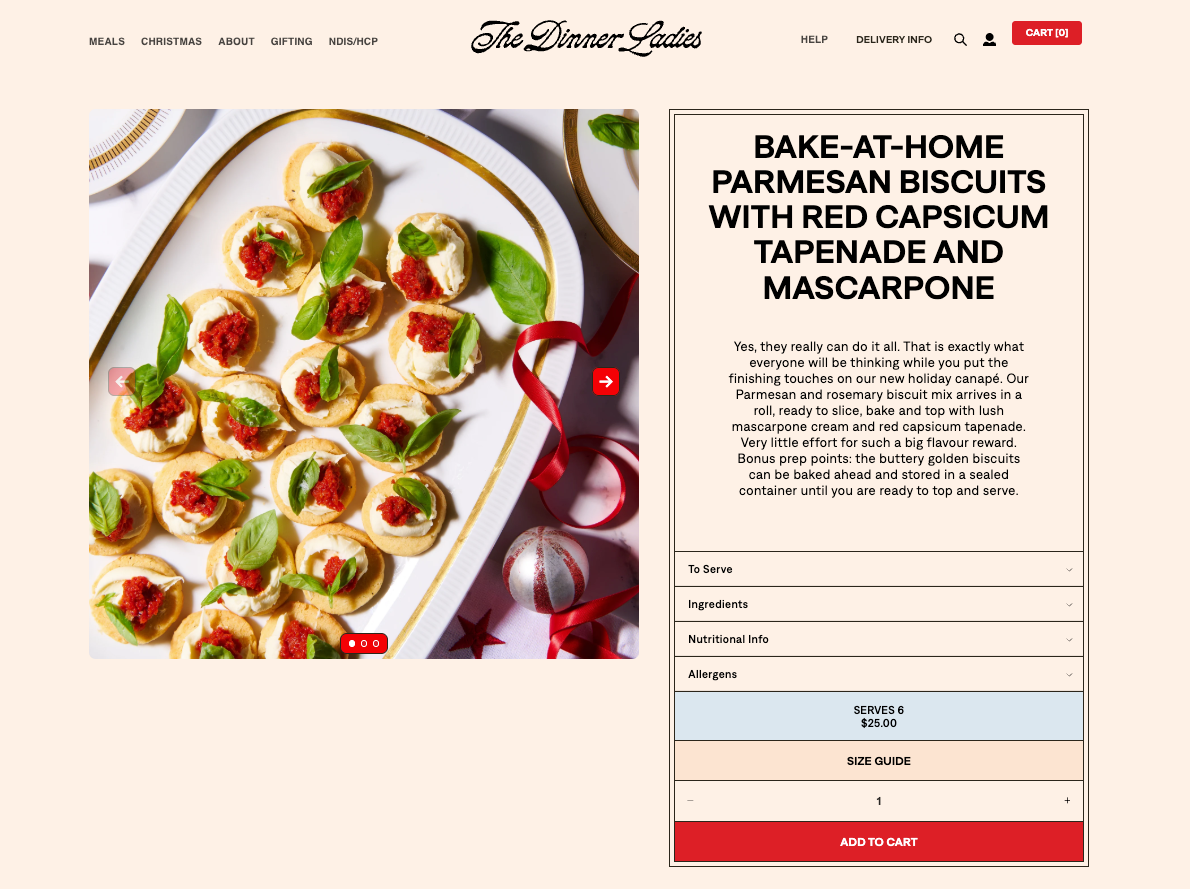
2) Craft additional Help Center and FAQ articles
FAQ pages make up the information hub of your website. They exist to provide customers with a way to get their questions answered without reaching out to you.
This includes information like how food should be stored, how long its shelf life is, delivery range, and serving instructions. FAQs can even direct customers toward finding out where their order is and what its status is.

In the context of BFCM, FAQs are all about deflecting repetitive questions away from your team and assisting shoppers in finding what they need faster.
That’s the strategy for German supplement brand mybacs.
“Our focus is to improve automations to make it easier for customers to self-handle their requests. This goes hand in hand with making our FAQs more comprehensive to give customers all the information they need,” says Alexander Grassmann, its Co-Founder & COO.
As you contemplate what to add to your FAQ page, remember that more information is usually better. That’s the approach Everyday Dose takes, answering even hyper-specific questions like, “Will it break my fast?” or “Do I have to use milk?”
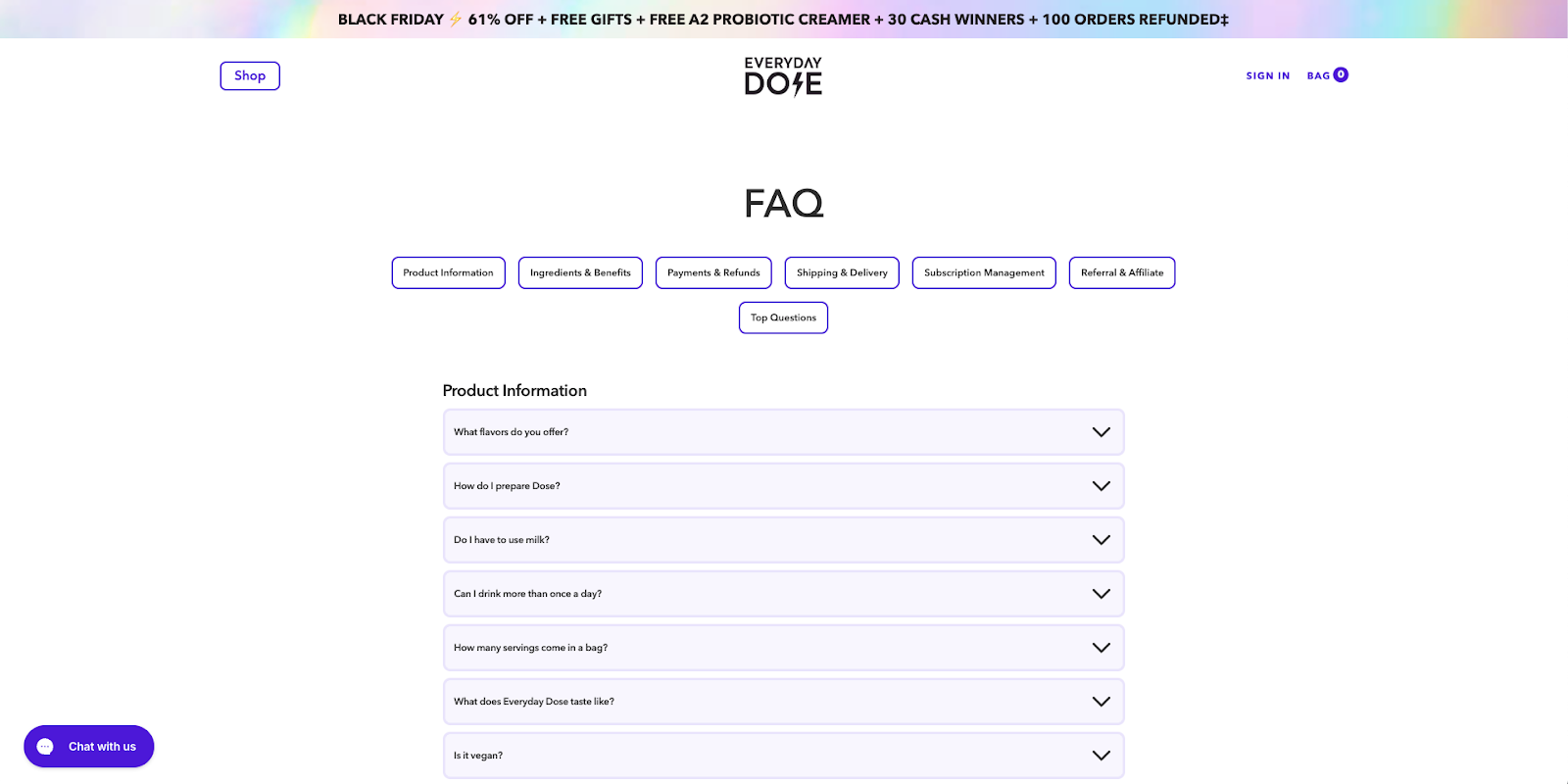
While the FAQs you choose to add will be specific to your products, peruse the top-notch food and bev FAQ pages below.
Time for some FAQ inspo:
- Juice Plus+ FAQ
- Everyday Dose FAQ
- Chamberlain Coffee FAQ
- Jurassic Fruit FAQ
- Rebel Cheese FAQ
- The Dinner Ladies FAQ
3) Automate responses with AI or macros
AI Agents and AI-powered Shopping Assistants are easy to set up and are extremely effective in handling customer interactions––especially during BFCM.
“I told our team we were going to onboard Gorgias AI Agent for BFCM, so a good portion of tickets would be handled automatically,” says Ron Shah, CEO and Co-founder at Obvi. “There was a huge sigh of relief knowing that customers were going to be taken care of.”
And, they’re getting smarter. AI Agent’s CSAT is just 0.6 points shy of human agents’ average CSAT score.
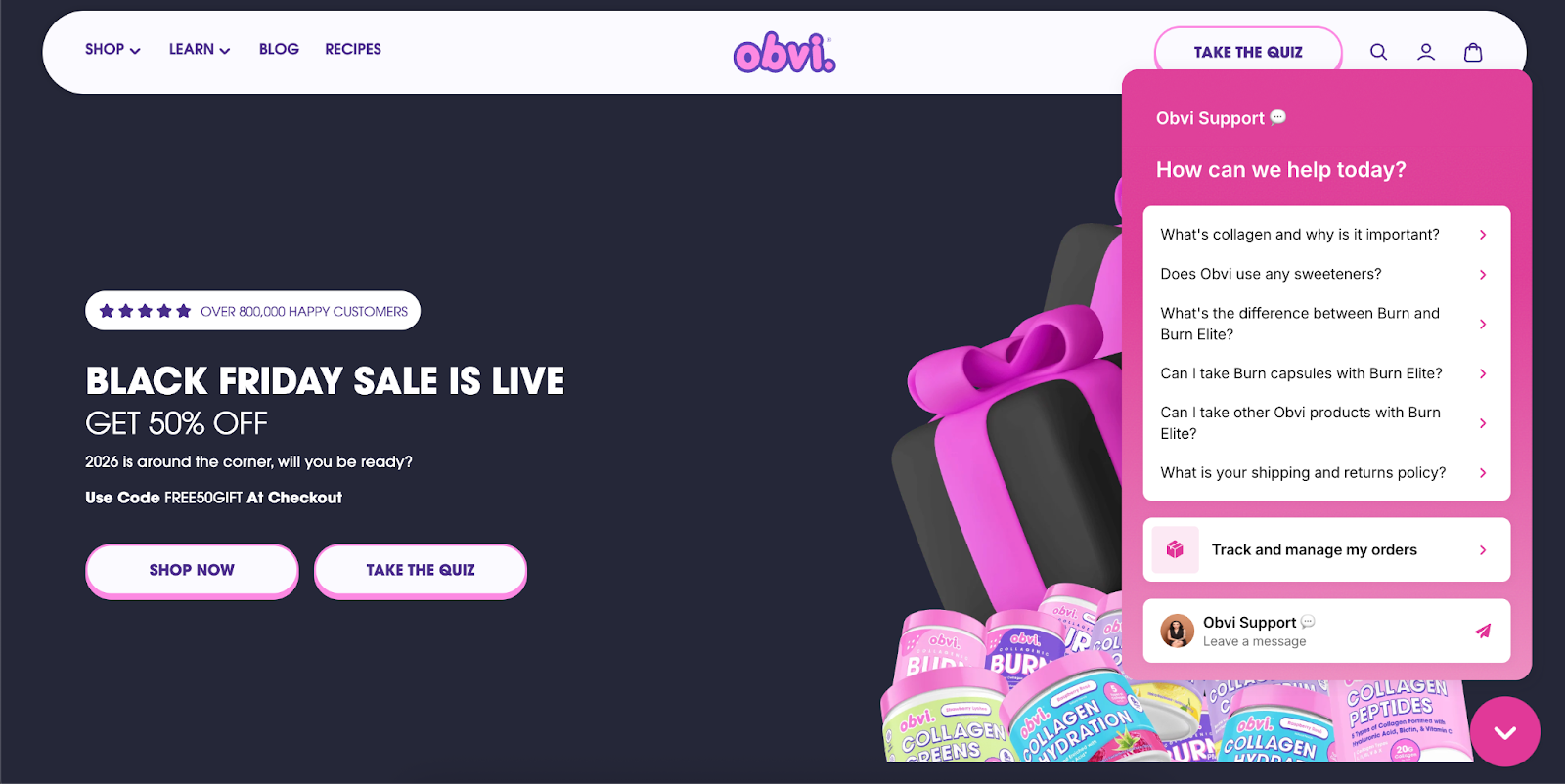
Here are the specific responses and use cases we recommend automating:
- WISMO (where is my order) inquiries
- Product related questions
- Returns
- Order issues
- Cancellations
- Discounts, including BFCM related
- Customer feedback
- Account management
- Collaboration requests
- Rerouting complex queries
Get your checklist here: How to prep for peak season: BFCM automation checklist
4) Get specific about product availability
With high price reductions often comes faster-than-usual sell out times. By offering transparency around item quantities, you can avoid frustrated or upset customers.
For example, you could show how many items are left under a certain threshold (e.g. “Only 10 items left”), or, like Rebel Cheese does, mention whether items have sold out in the past.

You could also set up presales, give people the option to add themselves to a waitlist, and provide early access to VIP shoppers.
5) Provide order cancellation and refund policies upfront
Give shoppers a heads up whether they’ll be able to cancel an order once placed, and what your refund policies are.
For example, cookware brand Misen follows its order confirmation email with a “change or cancel within one hour” email that provides a handy link to do so.
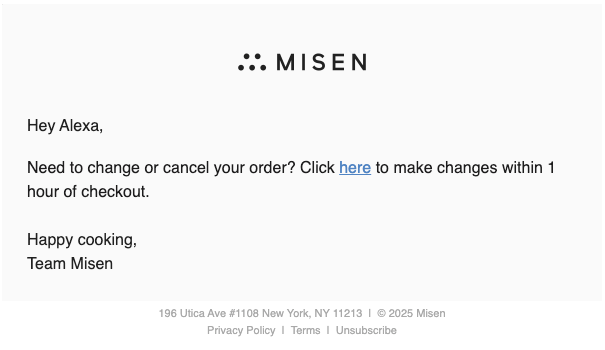
Your refund policies and order cancellations should live within an FAQ and in the footer of your website.
6) Add how-to information
Include how-to information on your website within your FAQs, on your blog, or as a standalone webpage. That might be sharing how to use a product, how to cook with it, or how to prepare it. This can prevent customers from asking questions like, “how do you use this?” or “how do I cook this?” or “what can I use this with?” etc.
For example, Purity Coffee created a full brewing guide with illustrations:
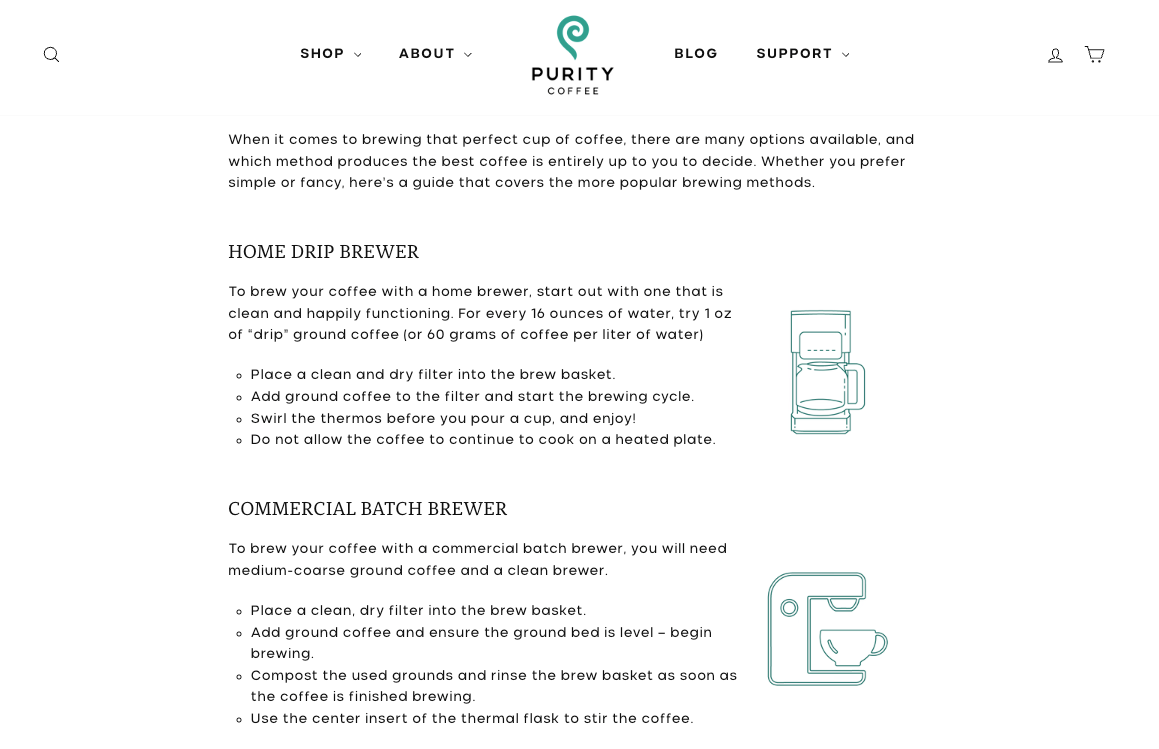
Similarly, for its unique preseasoned carbon steel pan, Misen lists out care instructions:

And for those who want to understand the level of prep and cooking time involved, The Dinner Ladies feature cooking instructions on each product page.

7) Build resources to help with buying decisions
Interactive quizzes, buying guides, and gift guides can help ensure shoppers choose the right items for them––without contacting you first.
For example, Trade Coffee Co created a quiz to help first timers find their perfect coffee match:
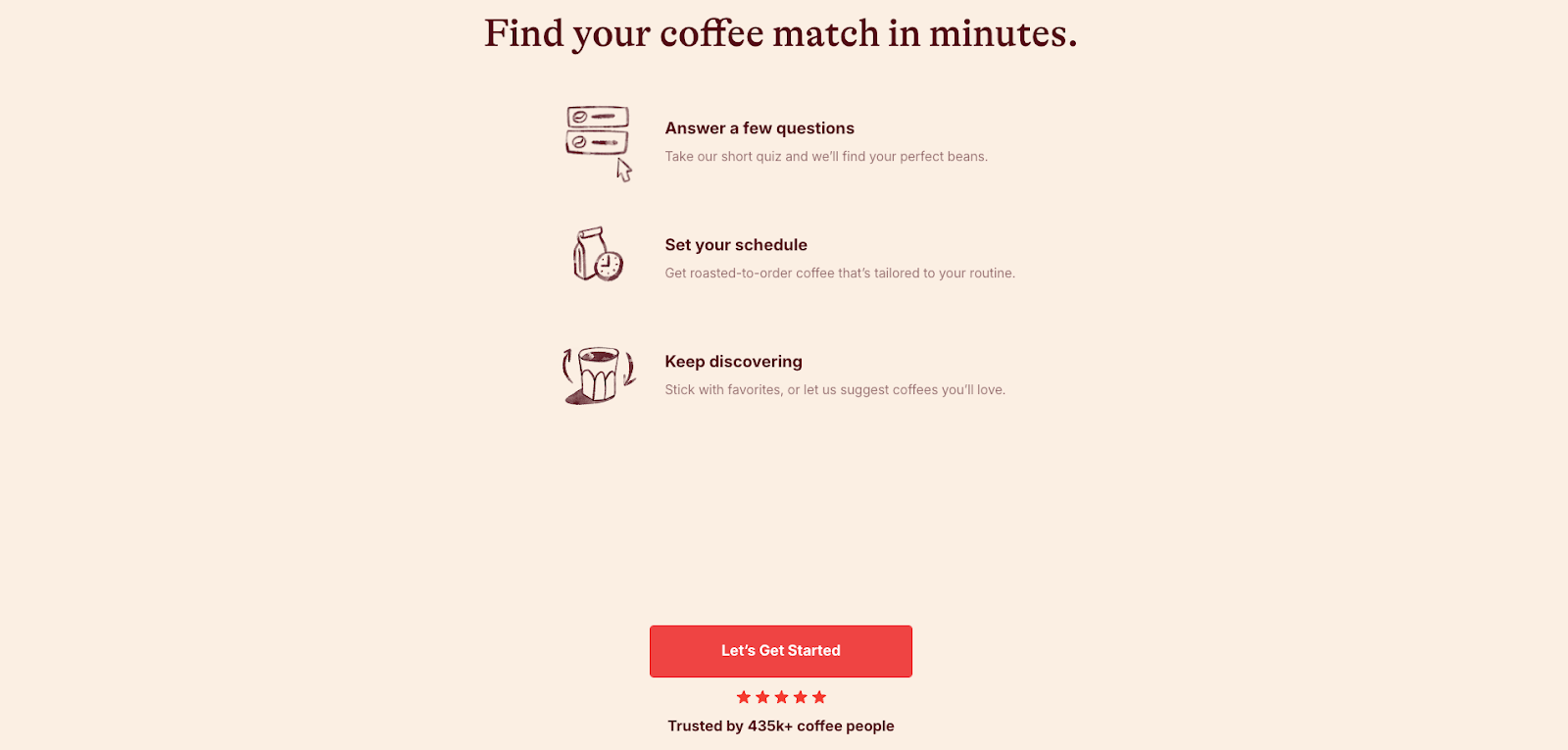
Set your team up for BFCM success with Gorgias
The more information you can share with customers upfront, the better. That will leave your team time to tackle the heady stuff.
If you’re looking for an AI-assist this season, check out Gorgias’s suite of products like AI Agent and Shopping Assistant.
{{lead-magnet-2}}
When Rhoback introduced an AI Agent to its customer experience team, it did more than automate routine tickets. Implementation revealed an opportunity to improve documentation, collaborate cross-functionally, and establish a clear brand tone of voice.
Samantha Gagliardi, Associate Director of Customer Experience at Rhoback, explains the entire process in the first episode of our AI in CX webinar series.
Key takeaways:
- Implement quickly and iterate. Rhoback’s initial rollout process took two weeks, right before BFCM. Samantha moved quickly, starting with basic FAQs and then continuously optimizing.
- Train AI like a three-year-old. Although it is empathetic, an AI Agent does not inherently know what is right or wrong. Invest in writing clear Guidance, testing responses, and ensuring document accuracy.
- Approach your AI’s tone of voice like a character study. Your AI Agent is an extension of your brand, and its personality should reflect that. Rhoback conducted a complete analysis of its agent’s tone, age, energy, and vocabulary.
- Embrace AI as a tool to reveal inconsistencies. If your AI Agent is giving inaccurate information, it’s exposing gaps in your knowledge sources. Uses these early test responses to audit product pages, help center content, Guidance, and policies.
- Check in regularly and keep humans in control. Introduce weekly reviews or QA rituals to refine AI’s accuracy, tone, and efficiency. Communicate AI insights cross-functionally to build trust and work towards shared goals.
Top learnings from Rhoback’s AI rollout
1. You can start before you “feel ready”
With any new tool, the pre-implementation phase can take some time. Creating proper documentation, training internal teams, and integrating with your tech stack are all important steps that happen before you go live.
But sometimes it’s okay just to launch a tool and optimize as you go.
Rhoback launched its AI agent two weeks before BFCM to automate routine tickets during the busy season.
Why it worked:
- Samantha had audited all of Rhoback’s SOPs, training materials, and FAQs a few months before implementation.
- They started by automating high-volume questions such as returns, exchanges, and order tracking.
- They followed a structured AI implementation checklist.
2. Audit your knowledge sources before you automate
Before turning on Rhoback’s AI Agent, Samantha’s team reviewed every FAQ, policy, and help article that human agents are trained on. This helped establish clear CX expectations that they could program into an AI Agent.
Samantha also reviewed the most frequently asked questions and the ideal responses to each. Which ones needed an empathetic human touch and which ones required fast, accurate information?
“AI tells you immediately when your data isn’t clean. If a product detail page says one thing and the help center says another, it shows up right away.”
Rhoback’s pre-implementation audit checklist:
- Review customer FAQs and the appropriate responses for each.
- Update outdated PDPs, Help Centre articles, policies, and other relevant documentation.
- Establish workflows with Ecommerce and Product teams to align Macros, Guidance, and Help Center articles with product descriptions and website copy.
Read more: How to Optimize Your Help Center for AI Agent
3. Train your AI Agent in small, clear steps
It’s often said that you should train your AI Agent like a brand-new employee.
Samantha took it one step further and recommended treating AI like a toddler, with clear, patient, repetitive instructions.
“The AI does not have a sense of good and bad. It’s going to say whatever you train it, so you need to break it down like you’re talking to a three-year-old that doesn’t know any different. Your directions should be so detailed that there is no room for error.”
Practical tips:
- Use AI to build your AI Guidance, focusing on clear, detailed, simple instructions.
- Test each Guidance before adding new ones.
- Treat the training process like an ongoing feedback loop, not a one-time upload.
Read more: How to Write Guidance with the “When, If, Then” Framework
4. Prioritize Tone of Voice to make AI feel natural
For Rhoback, an on-brand Tone of Voice was a non-negotiable. Samantha built a character study that shaped Rhoback’s AI Agent’s custom brand voice.
“I built out the character of Rhoback, how it talks, what age it feels like, what its personality is. If it does not sound like us, it is not worth implementing.”
Key questions to shape your AI Agent’s tone of voice:
- How does the AI Agent speak? Friendly, funny, empathetic, etc…?
- Does your AI Agent use emojis? How often?
- Are there any terms or phrases the AI Agent should always or never say?
5. Use AI to surface knowledge gaps or inconsistencies
Once Samantha started testing the AI Agent, it quickly revealed misalignment between Rhoback’s teams. With such an extensive product catalog, AI showed that product details did not always match the Help Center or CX documentation.
This made a case for stronger collaboration amongst the CX, Product, and Ecommerce teams to work towards their shared goal of prioritizing the customer.
“It opened up conversations we were not having before. We all want the customer to be happy, from the moment they click on an ad to the moment they purchase to the moment they receive their order. AI Agent allowed us to see the areas we need to improve upon.”
Tips to improve internal alignment:
- Create regular syncs between CX, Product, Ecommerce, and Marketing teams.
- Share AI summaries, QA insights, and trends to highlight recurring customer pain points.
- Build a collaborative workflow for updating documents that gives each team visibility.
6. Build trust (with your team and customers) through transparency
Despite the benefits of AI for CX, there’s still trepidation. Agents are concerned that AI would replace them, while customers worry they won’t be able to reach a human. Both are valid concerns, but clearly communicating internally and externally can mitigate skepticism.
At Rhoback, Samantha built internal trust by looping in key stakeholders throughout the testing process. “I showed my team that it is not replacing them. It’s meant to be a support that helps them be even more successful with what they’re already doing," Samantha explains.
On the customer side, Samantha trained their AI Agent to tell customers in the first message that it is an AI customer service assistant that will try to help them or pass them along to a human if it can’t.
How Rhoback built AI confidence:
- Positioned AI as a personal assistant for agents, not a replacement.
- Let agents, other departments, and leadership test and shape the AI Agent experience early.
- Told customers up front when automation was being used and made the path to a human clear and easy.
Read more: How CX Leaders are Actually Using AI: 6 Must-Know Lessons
Putting these into practice: Rhoback’s framework for an aligned AI implementation
Here is Rhoback’s approach distilled into a simple framework you can apply.
- Audit your content: Ensure your FAQs, product data, policies, and all documentation are accurate.
- Start small: Automate one repetitive workflow, such as returns or tracking.
- Train iteratively: Add Guidance in small, testable batches.
- Prioritize tone: Make sure every AI reply sounds like your brand.
- Align teams: Use AI data to resolve cross-departmental inconsistencies and establish clearer communication lines.
- Be transparent: Tell both agents and customers how AI fits into the process.
- Refine regularly: Review, measure, and adjust on an ongoing basis.
Watch the full conversation with Samantha to learn how AI can act as a catalyst for better internal alignment.
📌 Join us for episode 2 of AI in CX: Building a Conversational Commerce Strategy that Converts with Cornbread Hemp on December 16.
{{lead-magnet-1}}
TL;DR:
- You don’t need to rebuild your Help Center to make it work with AI—you just need to structure it smarter.
- AI Agent reads your content in three layers: Help Center, Guidance, and Actions, following an “if / when / then” logic to find and share accurate answers.
- Most AI escalations happen because Help Docs are vague or incomplete. Start by improving your top 10 ticket topics—like order status, returns, and refunds.
- Make your articles scannable, define clear conditions, link next steps, and keep your tone consistent. These small tweaks help AI Agent resolve more tickets on its own—and free up your team to focus on what matters most.
As holiday season support volumes spike and teams lean on AI to keep up, one frustration keeps surfacing, our Help Center has the answers—so why can’t AI find them?
The truth is, AI can’t help customers if it can’t understand your Help Center. Most large language models (LLMs), including Gorgias AI Agent, don’t ignore your existing docs, they just struggle to find clear, structured answers inside them.
The good news is you don’t need to rebuild your Help Center or overhaul your content. You simply need to format it in a way that’s easy for both people and AI to read.
We’ll break down how AI Agent reads your Help Center, finds answers, and why small formatting changes can help it respond faster and more accurately, so your team spends less time on escalations.
{{lead-magnet-1}}
How AI Agent uses your Help Center content
Before you start rewriting your Help Center, it helps to understand how AI Agent actually reads and uses it.
Think of it like a three-step process that mirrors how a trained support rep thinks through a ticket.
1. Read Help Center docs
Your Help Center is AI Agent’s brain. AI Agent uses your Help Center to pull facts, policies, and instructions it needs to respond to customers accurately. If your articles are clearly structured and easy to scan, AI Agent can find what it needs fast. If not, it hesitates or escalates.
2. Follow Guidance instructions
Think of Guidance as AI Agent’s decision layer. What should AI Agent do when someone asks for a refund? What about when they ask for a discount? Guidance helps AI Agent provide accurate answers or hand over to a human by following an “if/when/then” framework.
3. Respond and perform
Finally, AI Agent uses a combination of your help docs and Guidance to respond to customers, and if enabled, perform an Action on their behalf—whether that’s changing a shipping address or canceling an order altogether.
Here’s what that looks like in practice:
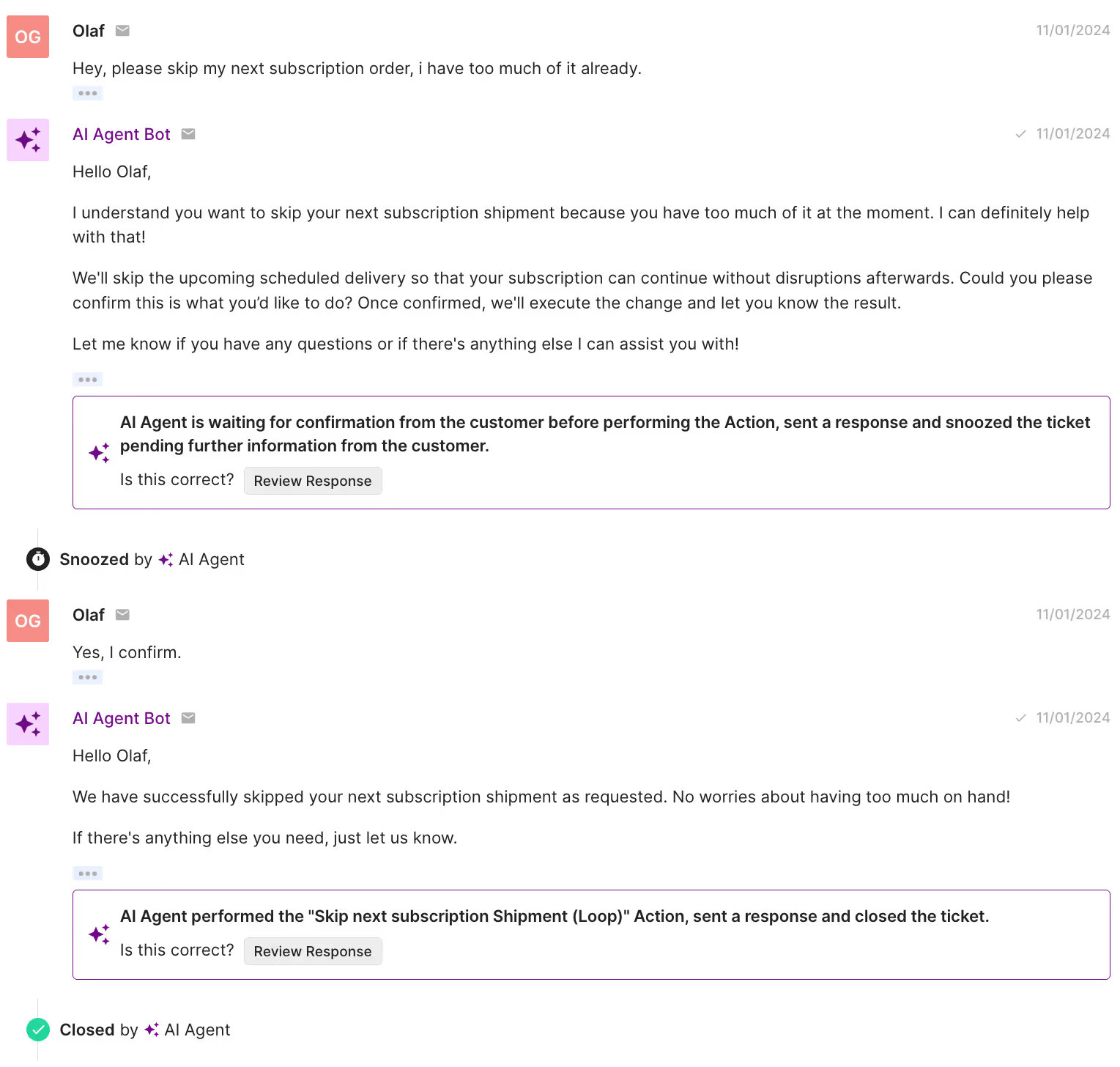
This structure removes guesswork for both your AI and your customers. The clearer your docs are about when something applies and what happens next, the more accurate and human your automated responses will feel.
A Help Center written for both people and AI Agent:
- Saves your team time
- Reduces escalations
- Helps every customer get the right answer the first time
What causes AI Agent to escalate tickets, and how to fix it
Our data shows that most AI escalations happen for a simple reason––your Help Center doesn’t clearly answer the question your customer is asking.
That’s not a failure of AI. It’s a content issue. When articles are vague, outdated, or missing key details, AI Agent can’t confidently respond, so it passes the ticket to a human.
Here are the top 10 topics that trigger escalations most often:
Rank |
Ticket Topic |
% of Escalations |
|---|---|---|
1 |
Order status |
12.4% |
2 |
Return request |
7.9% |
3 |
Order cancellation |
6.1% |
4 |
Product - quality issues |
5.9% |
5 |
Missing item |
4.6% |
6 |
Subscription cancellation |
4.4% |
7 |
Order refund |
4.1% |
8 |
Product details |
3.5% |
9 |
Return status |
3.3% |
10 |
Order delivered but not received |
3.1% |
Each of these topics needs a dedicated, clearly structured Help Doc that uses keywords customers are likely to search and spells out specific conditions.
Here’s how to strengthen each one:
- Order status: Include expected delivery timelines, tracking link FAQs, and a clear section for “what to do if tracking isn’t updating.”
- Return request: Spell out eligibility requirements, time limits, and how to print or request a return label.
- Order cancellation: Define cut-off times for canceling and link to your “returns” doc for shipped orders.
- Product quality issues: Explain what qualifies as a defect, how to submit photos, and whether replacements or refunds apply.
- Missing item: Clarify how to report missing items and what verification steps your team takes before reshipping.
- Subscription cancellation: Add “if/then” logic for different cases: if paused vs. canceled, if prepaid vs. monthly.
- Order refund: Outline refund timelines, where customers can see status updates, and any exceptions (e.g., partial refunds).
- Product details: Cover sizing, materials, compatibility, or FAQs that drive most product-related questions.
- Return status: State how long returns take to process and where to check progress once a label is scanned.
- Order delivered but not received: Provide step-by-step guidance for checking with neighbors, filing claims, or requesting replacements.
Start by improving these 10 articles first. Together, they account for nearly half of all AI Agent escalations. The clearer your Help Center is on these topics, the fewer tickets your team will ever see, and the faster your AI will resolve the rest.
How to format your Help Center docs for LLMs
Once you know how AI Agent reads your content, the next step is formatting your help docs so it can easily understand and use them.
The goal isn’t to rewrite everything, it’s to make your articles more structured, scannable, and logic-friendly.
Here’s how.
1. Use structured, scannable sections
Both humans and large language models read hierarchically. If your article runs together in one long block of text, key answers get buried.
Break articles into clear sections and subheadings (H2s, H3s) for each scenario or condition. Use short paragraphs, bullets, and numbered lists to keep things readable.
Example:
How to Track Your Order
- Step 1: Find your tracking number in your confirmation email.
- Step 2: Click the tracking link to see your delivery status.
- Step 3: If tracking hasn’t updated in 3 days, contact support.
A structured layout helps both AI and shoppers find the right step faster, without confusion or escalation.
2. Write for “if/when/then” logic
AI Agent learns best when your Help Docs clearly define what happens under specific conditions. Think of it like writing directions for a flowchart.
Example:
- “If your order hasn’t arrived within 10 days, contact support for a replacement.”
- “If your order has shipped, you can find the tracking link in your order confirmation email.”
This logic helps AI know what to do and how to explain the answer clearly to the customer.
3. Clarify similar terms and synonyms
Customers don’t always use the same words you do, and neither do LLMs. If your docs treat “cancel,” “stop,” and “pause” as interchangeable, AI Agent might return the wrong answer.
Define each term clearly in your Help Center and add small keyword variations (“cancel subscription,” “end plan,” “pause delivery”) so the AI can recognize related requests.
4. Link to next steps
AI Agent follows links just like a human agent. If your doc ends abruptly, it can’t guide the customer any further.
Always finish articles with an explicit next step, like linking to:
- A form
- Another article
- A support action page
Example: “If your return meets our policy, request your return label here.”
That extra step keeps the conversation moving and prevents unnecessary escalations.
5. Keep tone consistent
AI tools prioritize structure and wording when learning from your Help Center—not emotional tone.
Phrases like “Don’t worry!” or “We’ve got you!” add noise without clarity.
Instead, use simple, action-driven sentences that tell the customer exactly what to do:
- “Click here to request a refund.”
- “Fill out the warranty form to get a replacement.”
A consistent tone keeps your Help Center professional, helps AI deliver reliable responses, and creates a smoother experience for customers.
LLM-friendly Help Centers in action
You don’t need hundreds of articles or complex workflows to make your Help Center AI-ready. But you do need clarity, structure, and consistency. These Gorgias customers show how it’s done.
Little Words Project: Simple formatting that boosts instant answers
Little Words Project keeps things refreshingly straightforward. Their Help Center uses short paragraphs, descriptive headers, and tightly scoped articles that focus on a single intent, like returns, shipping, or product care.
That makes it easy for AI Agent to scan the page, pull out the right facts, and return accurate answers on the first try.
Their tone stays friendly and on-brand, but the structure is what shines. Every article flows from question → answer → next step. It’s a minimalist approach, and it works. Both for customers and the AI reading alongside them.
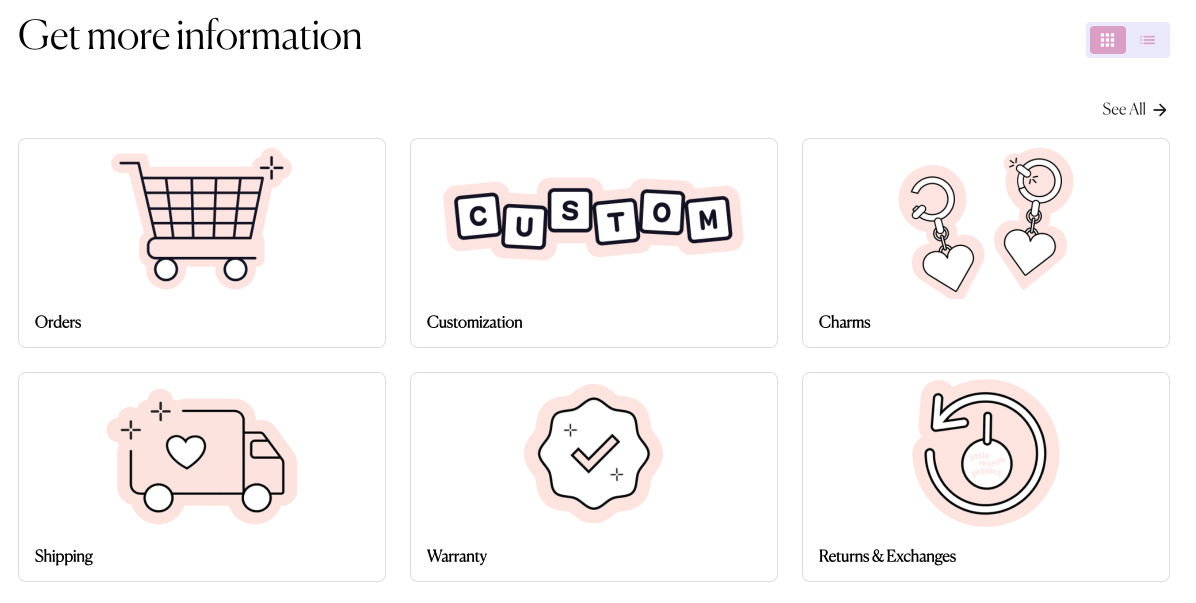
Dr. Bronner’s: Making tools work for the team
Customer education is at the heart of Dr. Bronner’s mission. Their customers often ask detailed questions about product ingredients, packaging, and certifications. With Gorgias, Emily and her team were able to build a robust Help Center that helped to proactively give this information.
The Help Center doesn't just provide information. The integration of interactive Flows, Order Management, and a Contact Form automation allowed Dr. Bronner’s to handle routine inquiries—such as order statuses—quickly and efficiently. These kinds of interactive elements are all possible out-of-the-box, no IT support needed.
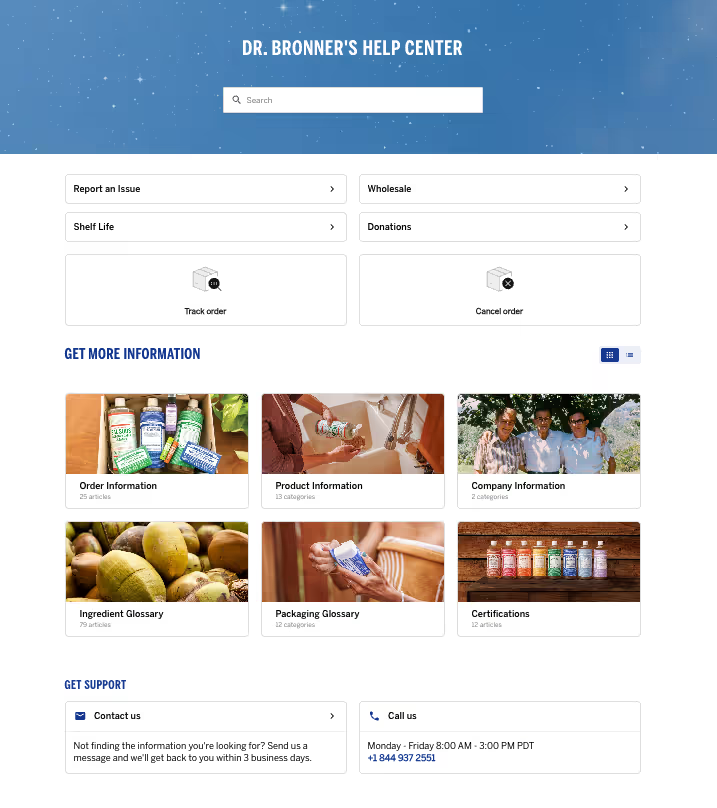
Ekster: Building efficiency through automation and clarity

When Ekster switched to Gorgias, the team wanted to make their Help Center work smarter. By writing clear, structured articles for common questions like order tracking, returns, and product details, they gave both customers and AI Agent the information needed to resolve issues instantly.
"Our previous Help Center solution was the worst. I hated it. Then I saw Gorgias’s Help Center features, and how the Article Recommendations could answer shoppers’ questions instantly, and I loved it. I thought: this is just what we need." —Shauna Cleary, Head of Ecommerce at Ekster
The results followed fast. With well-organized Help Center content and automation built around it, Ekster was able to scale support without expanding the team.
“With all the automations we’ve set up in Gorgias, and because our team in Buenos Aires has ramped up, we didn’t have to rehire any extra agents.” —Shauna Cleary, Head of Ecommerce at Ekster
Learn more: How Ekster used automation to cover the workload of 4 agents
Rowan: Clean structure that keeps customers (and AI) on track
Rowan’s Help Center is a great example of how clear structure can do the heavy lifting. Their FAQs are grouped into simple categories like piercing, shipping, returns, and aftercare, so readers and AI Agent can jump straight to the right topic without digging.
For LLMs, that kind of consistency reduces guesswork. For customers, it creates a smooth, reassuring self-service experience.
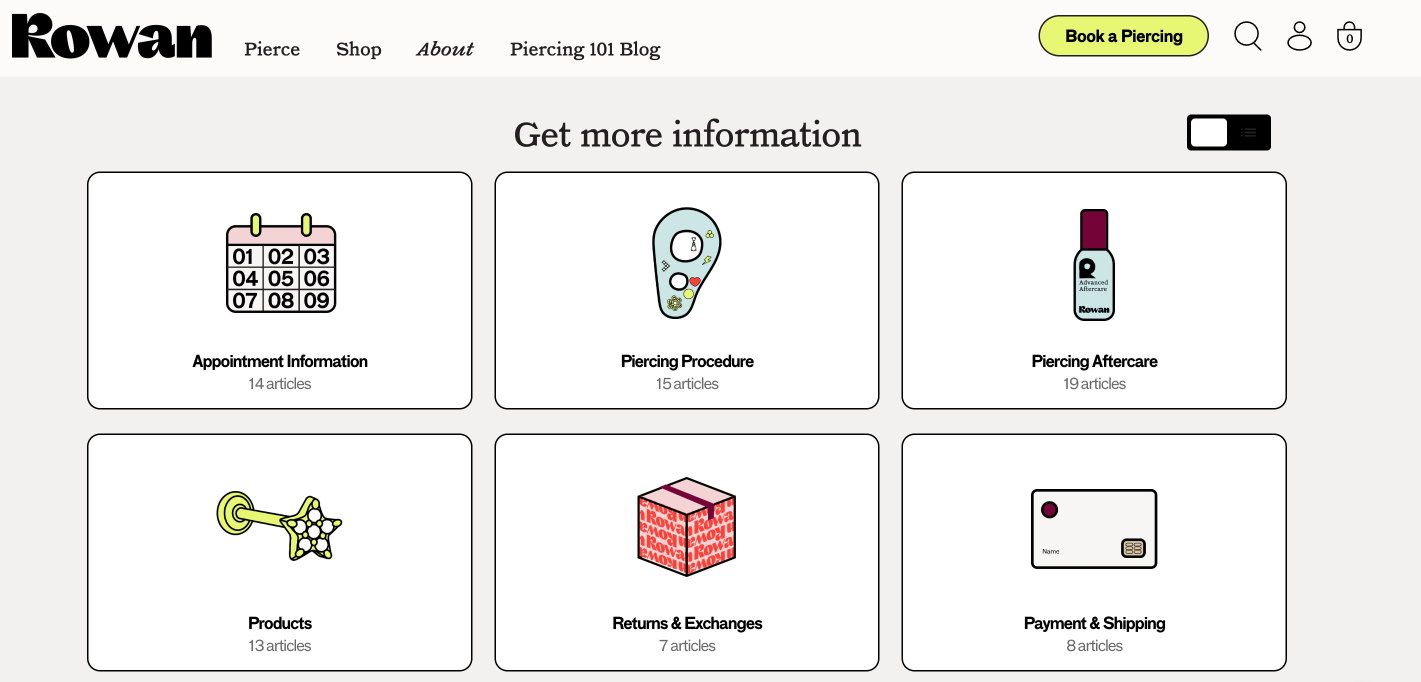
TUSHY: Balancing brand voice with automation
TUSHY proves you can maintain personality and structure. Their Help Center articles use clear headings, direct language, and brand-consistent tone. It makes it easy for AI Agent to give accurate, on-brand responses.
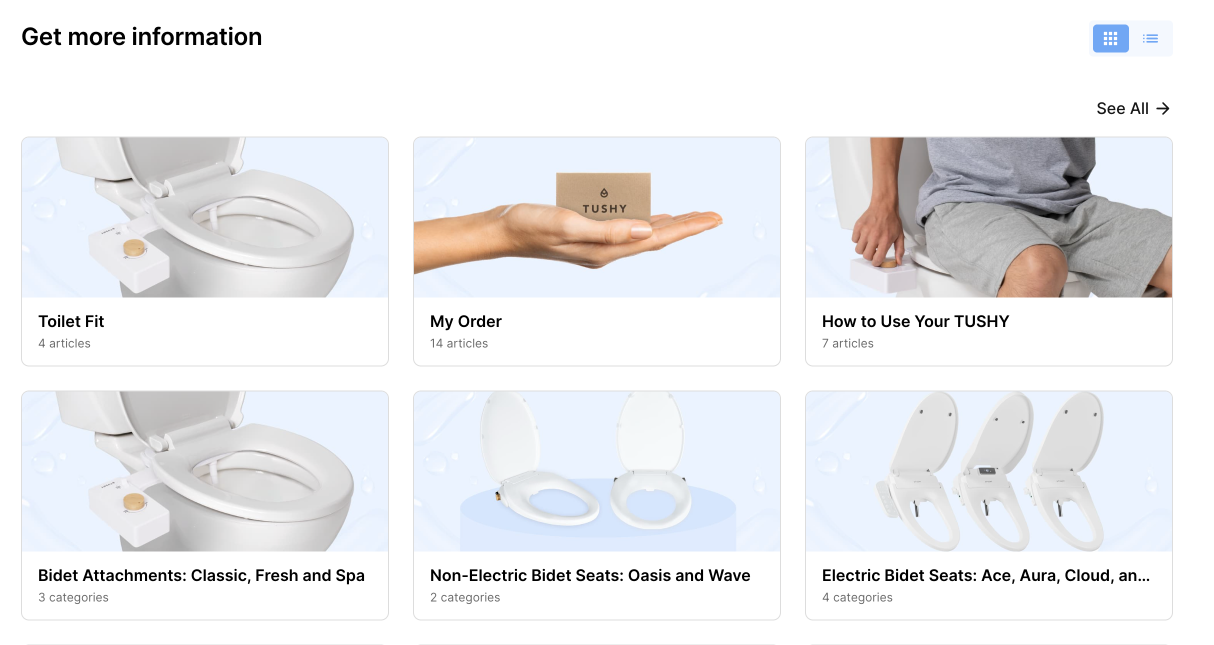
“Too often, a great interaction is diminished when a customer feels reduced to just another transaction. With AI, we let the tech handle the selling, unabashedly, if needed, so our future customers can ask anything, even the questions they might be too shy to bring up with a human. In the end, everybody wins!" —Ren Fuller-Wasserman, Senior Director of Customer Experience at TUSHY
Quick checklist to audit your Help Center for AI
Ready to put your Help Center to the test? Use this five-point checklist to make sure your content is easy for both customers and AI to navigate.
1. Are your articles scannable with clear headings?
Break up long text blocks and use descriptive headers (H2s, H3s) so readers and AI Agent can instantly find the right section.
2. Do you define conditions with “if/when/then” phrasing?
Spell out what happens in each scenario. This logic helps AI Agent decide the right next step without second-guessing.
3. Do you cover your top escalation topics?
Make sure your Help Center includes complete, structured articles for high-volume issues like order status, returns, and refunds.
4. Does each article end with a clear next step or link?
Close every piece with a call to action, like a form, related article, or support link, so neither AI nor customers hit a dead end.
5. Is your language simple, action-based, and consistent?
Use direct, predictable phrasing. Avoid filler like “Don’t worry!” and focus on steps customers can actually take.
By tweaking structure instead of your content, it’s easier to turn your Help Center into a self-service powerhouse for both customers and your AI Agent.
Make your Help Center work smarter
Your Help Center already holds the answers your customers need. Now it’s time to make sure AI can find them. A few small tweaks to structure and phrasing can turn your existing content into a powerful, AI-ready knowledge base.
If you’re not sure where to start, review your Help Center with your Gorgias rep or CX team. They can help you identify quick wins and show you how AI Agent pulls information from your articles.
Remember: AI Agent gets smarter with every structured doc you publish.
Ready to optimize your Help Center for faster, more accurate support? Book a demo today.
{{lead-magnet-2}}
Newsletter Signup
The best in CX and ecommerce, right to your inbox
Featured articles

How to Prep for Peak Season: BFCM Automation Checklist
TL;DR:
- Start by cleaning up your Help Center. Update your articles based on last year’s data, using plain language and clear policy details to boost self-service.
- Use automations to streamline ticket routing and support efficiency. Set rules for tagging, escalation, and inbox views, so your team can respond faster.
- Prep your macros, AI, and staffing plan in advance. Build responses for top FAQs, train AI on the right sources, and forecast agent needs to avoid burnout.
- Automate logistics, upselling, and QA to stay ahead. From showing shipping timelines to flagging low-quality responses, automation ensures smooth operations and more revenue during peak season.
Getting ready for that yearly ticket surge isn’t only about activating every automation feature on your helpdesk, it’s about increasing efficiency across your entire support operations.
This year, we’re giving you one less thing to worry about with our 2025 BFCM automation guide. Whether your team needs a tidier Help Center or better ticket routing rules, we’ve got a checklist for every area of the customer experience brought to you by top industry players, including ShipBob, Loop Returns, TalentPop, and more.
{{lead-magnet-1}}
2025 BFCM automation checklist
- Tidy up your Help Center
- Audit your docs
- Review last year’s BFCM data to find your must-have articles
- Update your policy details
- Edit content using easy-to-understand language
- Expedite your ticket routing automations
- Set up automated ticket tags
- Create an inbox view for each category
- Set escalation rules for urgent tickets
- Set up mandatory Ticket Fields
- Prep your macros and AI agent
- Write macros for your top FAQs
- Train your AI on the right sources
- Define the limits of what AI should handle
- Forecast your BFCM staffing needs
- Use ticket volume to estimate the number of agents
- Plan extra coverage with automation or outsourcing
- Run agent training sessions on BFCM protocols
- Map out your logistics processes
- Negotiate better rates and processing efficiencies
- Automate inventory reorder points
- Build contingency plans for disruptions
- Show shipping timelines on product pages
- Maximize profits with upselling automations
- Guide shoppers with smart recommendations
- Suggest alternatives when items are out of stock
- Engage hesitant shoppers with winback discounts
- Keep support quality high with QA automations
- Automate ticket reviews with AI-powered QA
- Track both agent and AI responses
- Turn QA insights into coaching opportunities
Tidy up your Help Center
Your customer knowledge base, FAQs, or Help Center is a valuable hub of answers for customers’ most asked questions. For those who prefer to self-serve, it’s one of the first resources they visit. To ensure customers get accurate answers, do the following:
- Audit your docs
- Review last year’s BFCM data to find your must-have articles
- Update your policy details
- Edit content using easy-to-understand language
1. Audit your docs
Take stock of what’s currently in your database. Are you still displaying low-engagement or unhelpful articles? Are articles about discontinued products still up? Start by removing outdated content first, and then decide which articles to keep from there.
Related: How to refresh your Help Center: A step-by-step guide
2. Review last year’s BFCM data to find your must-have articles
Are you missing key topics, or don’t have a database yet? Look at last year’s tickets. What were customers’ top concerns? Were customers always asking about returns? Was there an uptick in free shipping questions? If an inquiry repeats itself, it’s a sign to add it to your Help Center.
3. Update your policy details
An influx of customers means more people using your shipping, returns, exchanges, and discount policies. Make sure these have accurate information about eligibility, conditions, and grace periods, so your customers have one reliable source of truth.
Personalization tip: Loop Returns advises adjusting your return policy for different return reasons. With Loop’s Workflows, you can automatically determine which customers and which return reasons should get which return policies.
Read more: Store policies by industry, explained: What to include for every vertical
4. Edit content using easy-to-understand language
Customers want fast answers, so ensure your docs are easy to read and understand. Titles and answers should be clear. Avoid technical jargon and stick to simple sentences that express one idea. To accelerate the process, use AI tools like Grammarly and ChatGPT.
No time to set up a Help Center? Gorgias automatically generates Help Center articles for you based on what people are asking in your inbox.

Expedite your ticket routing automations
Think of ticket routing like running a city. Cars are your tickets (and customers), roads are your inboxes, and traffic lights are your automations and rules. The better you maintain these structures, the better they can run on their own without needing constant repairs from your CX team.
Here’s your ticket routing automation checklist:
- Tag every ticket
- Create views for each category you need (VIP, Returns, Troubleshooting, etc.)
- Set escalation rules for urgent tickets
- Set up mandatory Ticket Fields
1. Set up automated ticket tags
Instead of asking agents to tag every ticket, set rules that apply tags based on keywords, order details, or message type. A good starting point is to tag tickets by order status, returns, refunds, VIP customers, and urgent issues so your team can prioritize quickly.
Luckily, many helpdesks offer AI-powered tags or contact reasons to reduce manual work. For example, Gorgias automatically detects a ticket’s Contact Reason. The system learns from past interactions, tagging your tickets with more accuracy each time.

2. Create an inbox view for each category
Custom or filtered inbox views give your agents a filtered and focused workspace. Start with essential views like VIP customers, returns, and damages, then add specialized views that match how your team works.
If you’re using conversational AI to answer tickets, views become even more powerful. For example, you might track low CSAT tickets to catch where AI responses fall short or high handover rates to identify AI knowledge gaps. The goal is to reduce clutter so agents can focus on delivering support.
3. Set escalation rules for urgent tickets
Don’t get bogged down in minor issues while urgent tickets sit unanswered. Escalation rules make sure urgent cases are pushed to the top of your inbox, so they don’t risk revenue or lead to unhappy customers.
Tickets to escalate to agents or specialized queues:
- Lost packages
- Damaged items
- Defective items
- Failed payments
- Open tickets without a follow-up
4. Set up mandatory Ticket Fields to get data right off the bat
Ticket Fields add structure by requiring your team to capture key data before closing a ticket. For BFCM, make fields like Contact Reason, Resolution, and Return Reason mandatory so you always know why customers reached out and how the issue was resolved.
For CX leads, Ticket Fields removes guesswork. Instead of sifting through tickets one by one, you’ll have clean data to spot trends, report on sales drivers, and train your team.
Pro Tip: Use conditional fields to dig deeper without overwhelming agents. For example, if the contact reason is “Return,” automatically prompt the agent to log the return reason or product defect.
Prep your macros and AI agent
Macros and AI Agent are your frontline during BFCM. When prepped properly, they can clear hundreds of repetitive tickets. The key is to ensure that answers are accurate, up-to-date, and aligned with what you want AI to handle.
- Write macros for your most common FAQs
- Train your AI on the right sources
- Define the limits of what AI should handle
1. Write macros for your top FAQs
Customers will flood your inbox with the same questions: “Where’s my order?” “When will my discount apply?” “What’s your return policy?” Write macros that give short, direct answers up front, include links for details, and use placeholders for personalization.
Bad macro:
- “You can track your order with the tracking link. It should update soon.”
Good macro:
- “Hi {{customer_firstname}}, you can track your order here: {{tracking_link}}. Tracking updates may take up to 24 hours to appear. Here’s our shipping policy: [Help Center link].”
Pro Tip: Customers expect deep discounts this time of year. BPO agency C(x)atalyze recommends automating responses to these inquiries with Gorgias Rules. Include words such as “discount” AND “BFCM”, “holiday”, “Thanksgiving”, “Black Friday”, “Christmas”, etc.
2. Train your AI on the right sources
AI is only as good as the information you feed it. Before BFCM, make sure it’s pulling from:
- Your Help Center with updated FAQs and policies
- Internal docs on return windows, promos, and shipping cutoffs
- Product catalogs with the latest details and stock info
- BFCM-specific resources like discount terms or extended support hours
Double-check a few responses in Test Mode to confirm the AI is pulling the right information.

3. Define the limits of what AI should handle
Edge cases and urgent questions need a human touch, not an automated reply. Keep AI focused on quick requests like order status, shipping timelines, or promo eligibility. Complex issues, like defective products, VIP complaints, and returns, can directly go to your agents.
Pro Tip: In Gorgias AI Agent settings, you can customize how handovers happen on Chat during business hours and after hours.
Forecast your BFCM staffing needs
Too few agents and you prolong wait times and miss sales. Too many and you’ll leave your team burned out. Capacity planning helps you find the balance to handle the BFCM surge.
1. Use ticket volume to estimate the number of agents
Use your ticket-to-order ratio from last year as a baseline, then apply it to this year’s forecast. Compare that number against what your team can realistically handle per shift to see if your current staffing plan holds up.
Read more: How to forecast customer service hiring needs ahead of BFCM
2. Plan extra coverage with automation or outsourcing
You still have options if you don’t have enough agents helping you out. Customer service agency TalentPop recommends starting by identifying where coverage will fall short, whether that’s evenings, weekends, or specific channels. Then decide whether to increase automation and AI use or bring in temporary assistance.
3. Run agent training sessions on BFCM protocols
Before the holiday season, run refreshers on new products, promos, and policy changes so no one hesitates when the tickets roll in. Pair training with cheat sheets or an internal knowledge base, giving your team quick access to the answers they’ll need most often.
Map out your logistics processes
Expect late shipments, low inventory, and more returns than usual during peak season. With the proper logistics automations, you can stay ahead of these issues while reducing pressure on your team.
ShipBob and Loop recommend the following steps:
- Negotiate better rates and processing efficiencies
- Automate your reverse logistics
- Connect your store, 3PL, and WMS
- Automate inventory reorder points
- Show shipping timelines on product pages
1. Negotiate better rates and processing efficiencies
Shipping costs add up fast during peak season. Work with your 3PL or partners like Loop Returns to take advantage of negotiated carrier rates and rate shopping tools that automatically select the most cost-effective option for each order.
2. Automate inventory reorder points
To maintain a steady supply of products, set automatic reorder points at the SKU level so reorders are triggered once inventory dips below a threshold. More lead time means fewer ‘out of stock’ surprises for your customers.
3. Build contingency plans for disruptions
Bad weather, delays, or unexpected demand can disrupt shipping timelines. Create a playbook in advance so your team knows exactly how to respond when things go sideways. At minimum, your plan should cover:
- Weather disruptions - Do you have a backup plan if carriers can’t pick up shipments due to storms or severe conditions?
- Carrier overloads - Which alternative carriers or routes can you switch to if primary partners are at capacity?
- Inventory shortages - How will you handle overselling, low stock alerts, or warehouse imbalances?
- Demand drop-offs - How will you reallocate inventory if BFCM sales don’t match forecasts?
4. Show shipping timelines on product pages
Customers want to know when their order will arrive before they hit checkout. Add estimated delivery dates and 2-day shipping badges directly on product pages. These cues help shoppers make confident decisions and reduce pre-purchase questions about shipping times.
Pro Tip: To keep those timelines accurate, build carrier cutoff dates into your Black Friday logistics workflows with your 3PL or fulfillment team. This allows you to avoid promising delivery windows your carriers can’t meet during peak season.
Maximize profits with upselling automations
You’ve handled the basics, from ticket routing to staffing and logistics. Now it’s time to go beyond survival. Upselling automations create an end-to-end experience that enhances the customer journey, shows them products they’ll love, and makes it easy to buy more with confidence. To put them to work:
- Guide shoppers with smart recommendations
- Suggest alternatives when items are out of stock
- Engage hesitant shoppers with winback discounts
1. Guide shoppers with smart recommendations
BFCM puts pressure on customers to find the right deal fast, but many don’t know what they’re looking for. Make it easier for them with macros that point shoppers to bestsellers or curated bundles. For a more advanced option, conversational AI like Gorgias Shopping Assistant can guide browsers on their own, even when your agents are offline.
2. Suggest alternatives when items are out of stock
No need to damage your conversion rate just because customers missed the items they wanted. Automations can recommend similar or complementary products, keeping customers engaged rather than leaving them empty-handed.
If an item is sold out, set up automations to:
- Suggest similar items like another size, color, or variation of the same product.
- Highlight premium upgrades such as a newer model or higher-value version that’s in stock.
- Cross-sell and offer bundles to keep the order valuable even without the original item.
- Notify customers about restocks by letting shoppers sign up for back-in-stock alerts.
3. Engage hesitant customers with winback discounts
Automations can detect hesitation through signals like abandoned carts, long checkout times, or even customer messages that mention keywords such as “too expensive” or “I’ll think about it.” In these cases, trigger a small discount to encourage the purchase.
You can take this a step further with conversational AI like Gorgias Shopping Assistant, which detects intent in real time. If a shopper seems uncertain, it can proactively offer a discount code based on the level of their buying intent.
Keep support quality high with QA automations
During BFCM, speed alone is not enough. Customers expect accurate, helpful, and on-brand responses, even when volume is at its highest. QA automations help you prioritize quality by reviewing every interaction automatically and flagging where standards are slipping. To make QA part of your automation prep:
- Automate ticket reviews with AI-powered QA
- Track both agent and AI responses
- Turn QA insights into coaching opportunities
1. Automate ticket reviews with AI-powered QA
Manual QA can only spot-check a small sample of tickets, which means most interactions go unreviewed. AI QA reviews every ticket automatically and delivers feedback instantly. This ensures consistent quality, even when your team is flooded with requests.
Compared to manual QA, AI QA offers:
- Full coverage: Every ticket is reviewed, not just a sample.
- Instant feedback: Agents get insights right after closing tickets.
- Consistency: Reviews are unbiased and use the same criteria across all interactions.
- Scalability: Works at any ticket volume without slowing down your team.
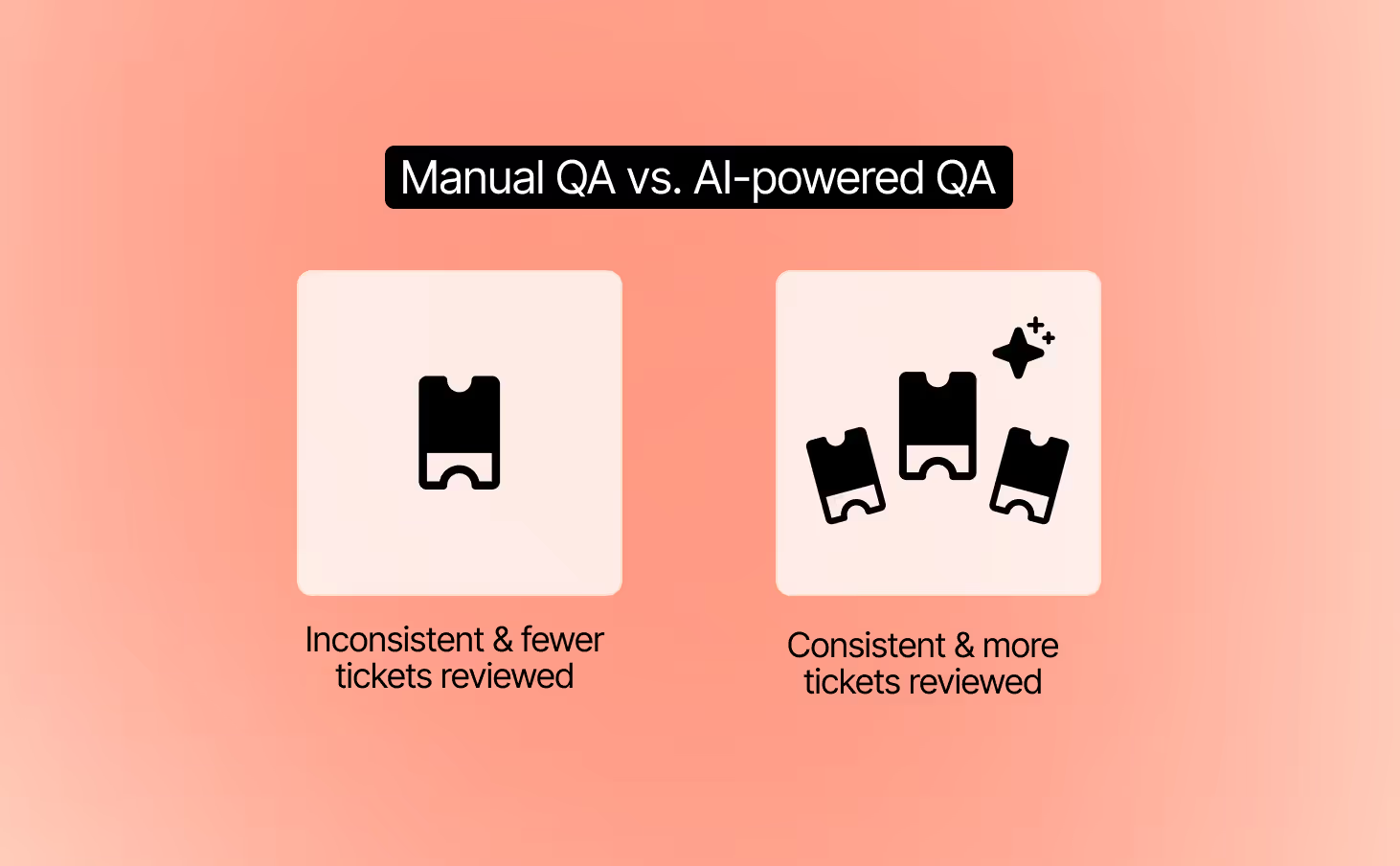
2. Track both agent and AI responses
Customers should get the same level of quality no matter who replies. AI QA evaluates both human and AI conversations using the same criteria. This creates a fair standard and gives you confidence that every interaction meets your brand’s bar for quality.
3. Turn QA insights into coaching opportunities
QA automation is not just about grading tickets. It highlights recurring issues, unclear workflows, or policy confusion. Use these insights to guide targeted coaching sessions and refine AI guidance so both humans and AI deliver better results.
Pro Tip: Pilot your AI QA tool with a small group of agents before peak season. This lets you validate feedback quality and scale with confidence when BFCM volume hits.
Give your ecommerce strategy a boost this holiday shopping season
The name of the game this Black Friday-Cyber Monday isn’t just to get a ton of online sales, it’s to set up your site for a successful holiday shopping season.
If you want to move the meter, focus on setting up strong BFCM automation flows now.
Gorgias is designed with ecommerce merchants in mind. Find out how Gorgias’s time-saving CX platform can help you create BFCM success. Book a demo today.
{{lead-magnet-2}}
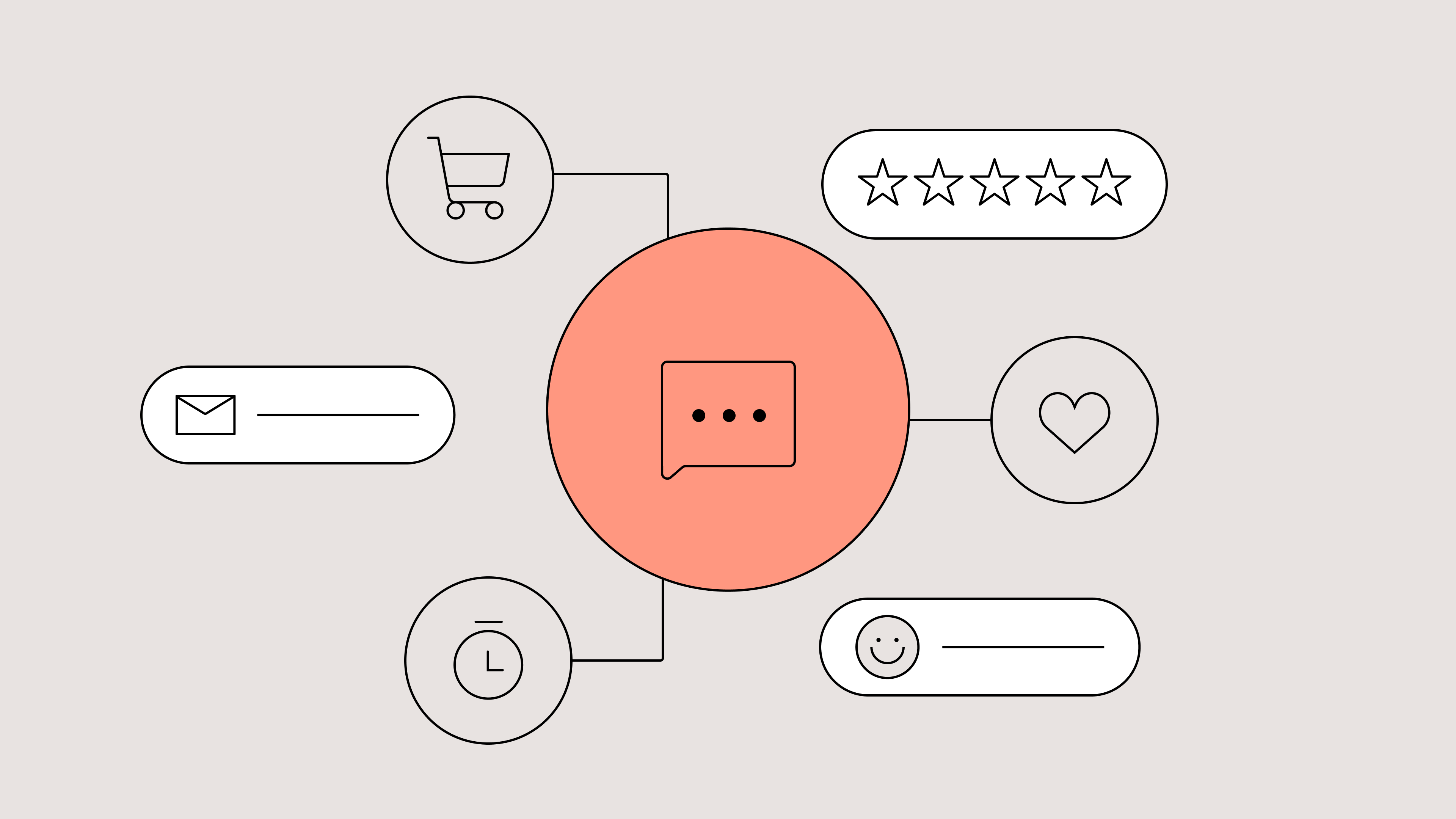
The Power of Suggestion: Why Subtle Cues Create Better Conversations
TL;DR:
- Suggestion turns browsing into buying by gently guiding action instead of forcing it.
- Fewer, clearer choices reduce decision fatigue and help shoppers move forward with confidence.
- A well-timed prompt with a friendly tone can make automation feel like a real conversation.
- Good design earns trust by being subtle, approachable, and easy to engage with.
- Small, thoughtful cues create moments of connection that make shoppers feel understood.
Shopping today isn’t a linear funnel. It’s a fluid conversation. Browse → question → help → buy → return → repeat.
Every step is a dialogue between the shopper’s intent and the brand’s response.
But what bridges the gap between “just looking” and “I’m buying” isn’t persuasion or urgency — it’s suggestion: the subtle design, timing, and language cues that guide action without forcing it.
When done well, suggestion becomes the architecture of trust. It’s also the best way to make AI-powered experiences feel human-first, not tech-first.
This article explores how the power of suggestion — rooted in behavioral psychology and UX design — shapes modern conversational commerce.
{{lead-magnet-1}}
Why suggestion matters in the age of conversational commerce
The average ecommerce shopper faces thousands of micro-decisions from the moment they land on a site. Which product? Which variant? Which review to trust? Which shipping method? Each one adds cognitive weight.
Psychologist Barry Schwartz coined the term The Paradox of Choice to describe how abundance often leads to paralysis. In his research, participants faced with too many options were less likely to make a choice and less satisfied when they did.
In ecommerce, that means overload costs conversions. When shoppers must evaluate too many variables, they hesitate, second-guess, or abandon.
Shoppers today expect empathy and ease, not persuasion. When you suggest rather than push, you signal empathy and support.
This is especially important for conversational commerce. Suggestion humanizes automation by making AI interactions feel like conversations rather than transactions.
When you push and persuade, you create a memorable experience for customers — but it’s not the kind you want them to remember.
One Reddit thread perfectly captures the problem: a user tried to cancel their Thrive Market membership and had to ask nine times before the chatbot complied.
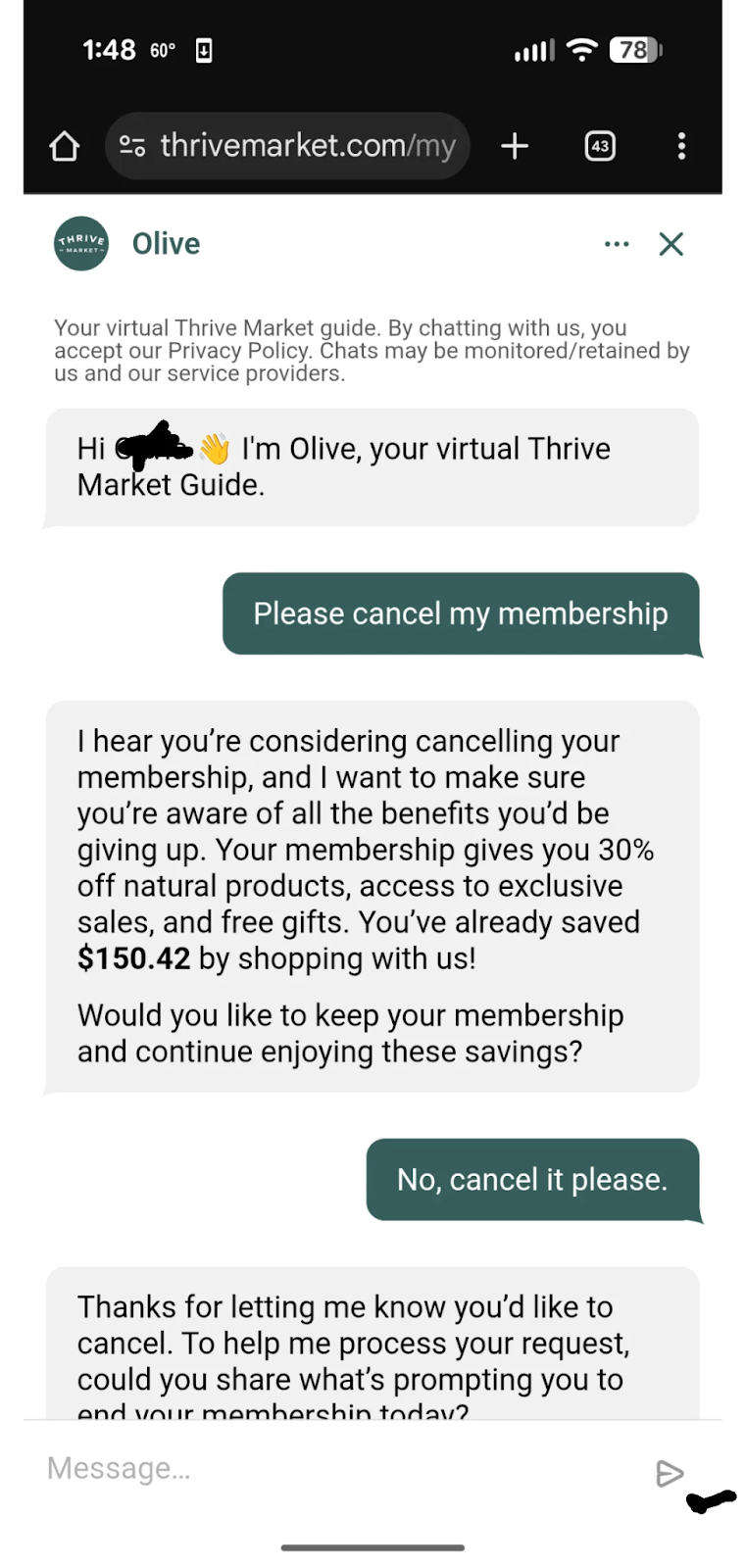
Each time, the AI assistant tried to talk them out of it (offering deals, guilt-tripping responses, or irrelevant messages) until the customer’s frustration boiled over.
The thread exploded not just because it was mildly infuriating, but because it illustrated what customers fear most about automation: a lack of empathy.
Suggestion is how you design for trust, ease, and interaction. And for ecommerce and CX professionals, suggestion bridges browsing and buying by prompting dialogue in a gentle, psychologically sound way.
5 ways to use suggestion with agentic AI
The magic of suggestion is that it works with human psychology, not against it. It bridges the space between what a shopper wants to do and what helps them do it.
That’s the foundation of the Fogg Behavior Model, developed by Stanford’s Dr. BJ Fogg. The model states that behavior happens when three things intersect:
- Motivation — the user wants to do something.
- Ability — they can do it easily.
- Prompt — they’re nudged at the right moment.
When these three align, the likelihood of action skyrockets.
In conversational commerce, suggestion is the gentle push that turns intent into interaction.
Below are five ways to apply suggestion with agentic AI (think chat, assistants, and marketing tools) to drive trust, dialogue, and conversion.
1. Build trust with a friendly invitation
A first impression shapes the entire interaction.
A greeting like “Need help?” or “Looking for something special?” signals availability without applying pressure. It’s the digital equivalent of a store associate smiling and saying, “Let me know if you need anything.”
This works because of linguistic framing, which is a form of persuasive language that subtly shapes how people interpret intent.
- Sentences using personal pronouns (“you,” “we”) increase perceived warmth and empathy.
- Questions (vs. imperatives) activate a conversational schema in the brain, inviting a cooperative response.
- Short, low-stakes phrasing signals that engagement is voluntary.
In practice, this means:
- Replace “Start chat now” with “Need a hand finding the right fit?”
- Use punctuation and tone cues that convey friendliness.
- Let the chat invite linger rather than pop up suddenly — this gives users agency.
Take a look at Glamnetic. Its shopping assistant sits at the bottom-right corner of every page. While shoppers scroll on the homepage, a prompt appears: “Shop with AI.” It’s transparent about being an AI chat, but subtle enough to be there for shoppers when they’re ready to use it at their own leisure.

Gorgias Shopping Assistant is an easy way to do this. At the right moment, Shopping Assistant appears with a greeting such as “Need help?” or “Chat with our AI!” It’s friendly, low-pressure, optional, more “Hey I’m here if you need” than “Buy now!”
2. Make decisions easier by offering fewer choices
If you’ve ever scrolled through 80 product filters and given up, you’ve experienced choice overload. This is the Paradox of Choice in action:
More options = higher cognitive effort = lower satisfaction.
Suggestion works because it reduces mental effort. When an AI assistant limits quick-reply options to just a few (say, “Long sleeve,” “Short sleeve,” “Sleeveless”), it transforms chaos into clarity.
Each small tap provides forward momentum, a concept known as the goal-gradient effect: the closer we feel to completing a goal, the faster and more positively we act.
How can you apply this to agentic AI?
- Keep quick replies between 3–5 choices — enough to feel personalized, not overwhelming.
- Present them as progressive steps, not isolated decisions (e.g., “Show me styles” → “Show me colors” → “Add to cart”).
- Always include a “Something else” or “Other” option to preserve user autonomy.
- Refresh options dynamically based on prior selections — a technique known as choice scaffolding.
Gorgias’s Shopping Assistant does this well, surfacing only the most relevant next steps. Instead of forcing open-ended typing, it guides shoppers through mini-decisions that build confidence. Here’s an example from Okanui, showing four clear options to reply to Shopping Assistant.
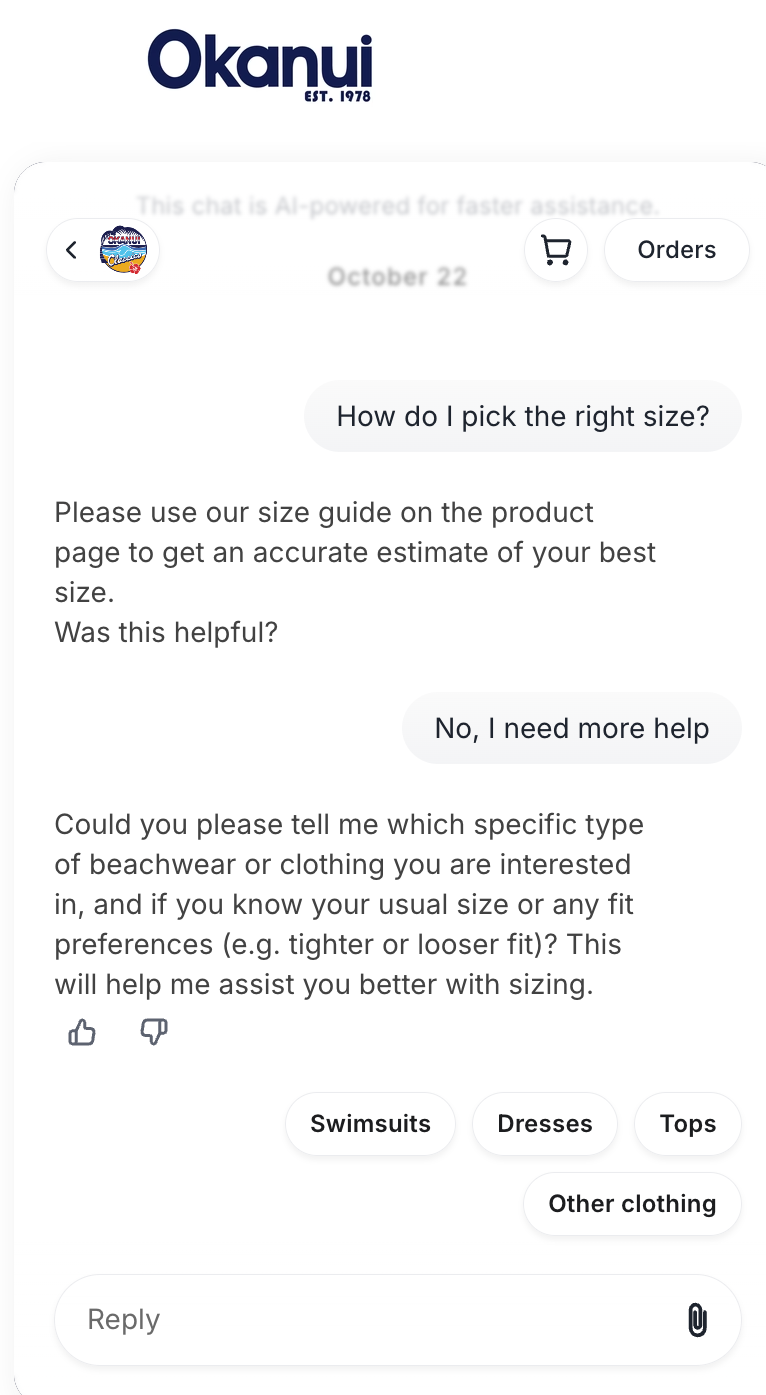
3. Encourage interaction with a user-friendly design
Before a shopper reads a single word of text, their brain has already judged whether your interface feels safe to engage with.
That’s the Aesthetic–Usability Effect — when people perceive something as visually appealing, they assume it will be easier and more trustworthy to use.
Design psychologist Don Norman put it best: “Attractive things work better because they make people feel better.”
Here’s why visual subtlety matters:
- Rounded edges and soft shapes signal continuity and friendliness (the human brain associates curves with safety; sharp angles with danger).
- Muted palettes and neutral contrast lower visual stress, allowing the interface to fade into the background until needed.
- Micro-animations — like a gentle glow or slide-in — trigger attention without hijacking focus.
- Minimizable elements give users a sense of control, reducing resistance to engagement.
OSEA’s product description page is a beautiful example of unintrusive design in action. The buttons have rounded edges, the 10% offer isn’t covering other page elements, and the chat sits in the bottom-right corner, making it easily accessible if a shopper has questions about the product.
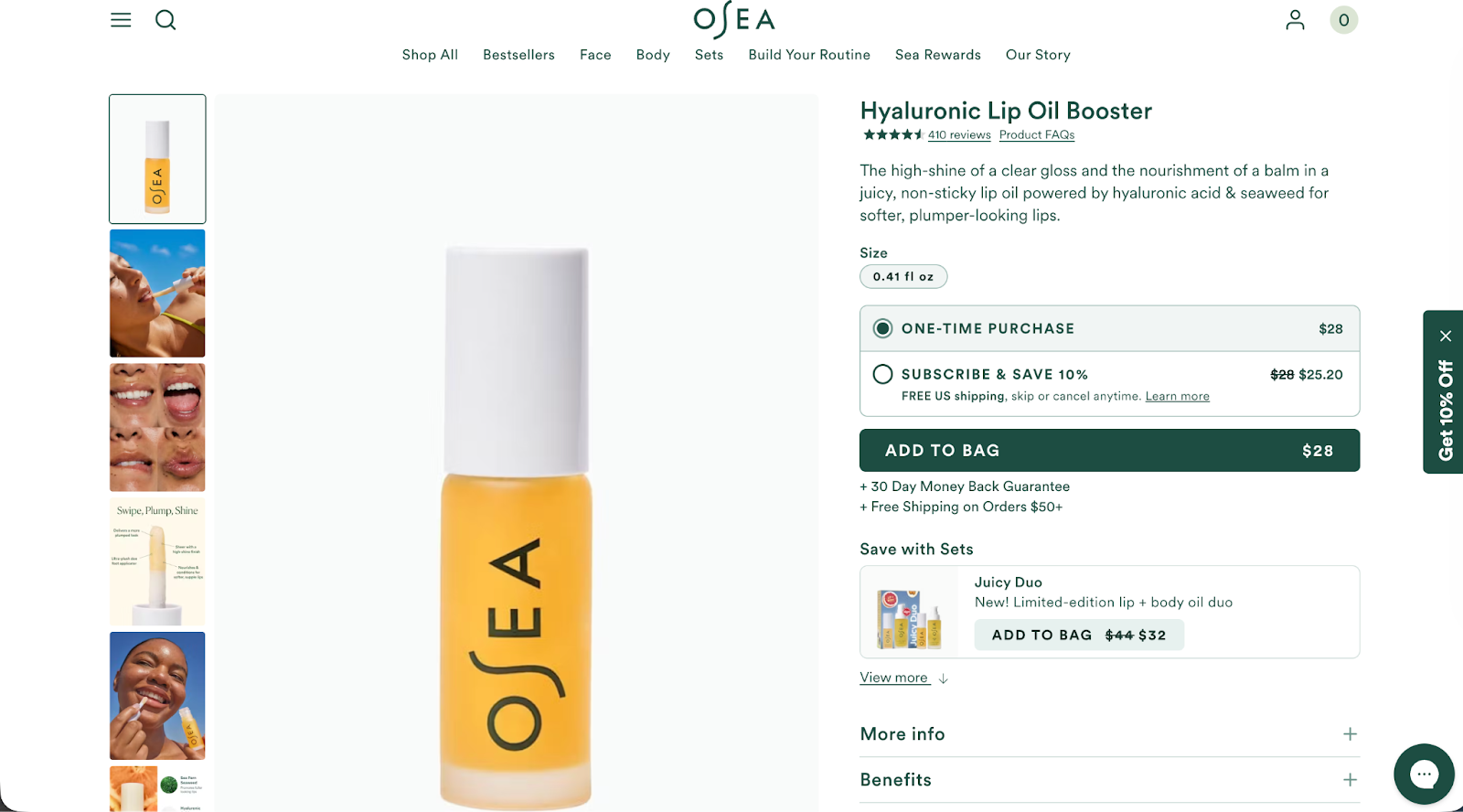
4. Match your timing to the customer’s pace
Timing is everything in suggestion-based design. Even the most thoughtful interaction will fail if it appears at the wrong moment.
That’s where the Fogg Behavior Model becomes tactical: Behavior = Motivation × Ability × Prompt
When shoppers are motivated (interested in a product) and able (engaging is easy), a well-timed prompt (chat bubble, message, or offer) turns potential into action.
But mistime it, and you risk the opposite. A chat that appears too early feels like spam. Too late, and the user’s interest window closes.
Here’s how to align the timing sweet spot:
- Use behavioral triggers: Fire prompts after meaningful engagement (e.g., 25–30 seconds on a product page, reaching 70% scroll depth, or idling for 15 seconds).
- Match prompt to context: Offer size guidance on apparel pages, warranty info near checkout, or live help on return pages.
- Respect frequency: One well-placed nudge beats five redundant ones.
- Localize timing: Adjust based on device and location. Mobile users often need faster cues due to shorter browsing sessions.
Gorgias Shopping Assistant does all of the above. Using context — such as the current page, conversational context, and cart behavior — helps the AI trigger prompts like “Need help choosing a size?” or “Have questions about shipping?”
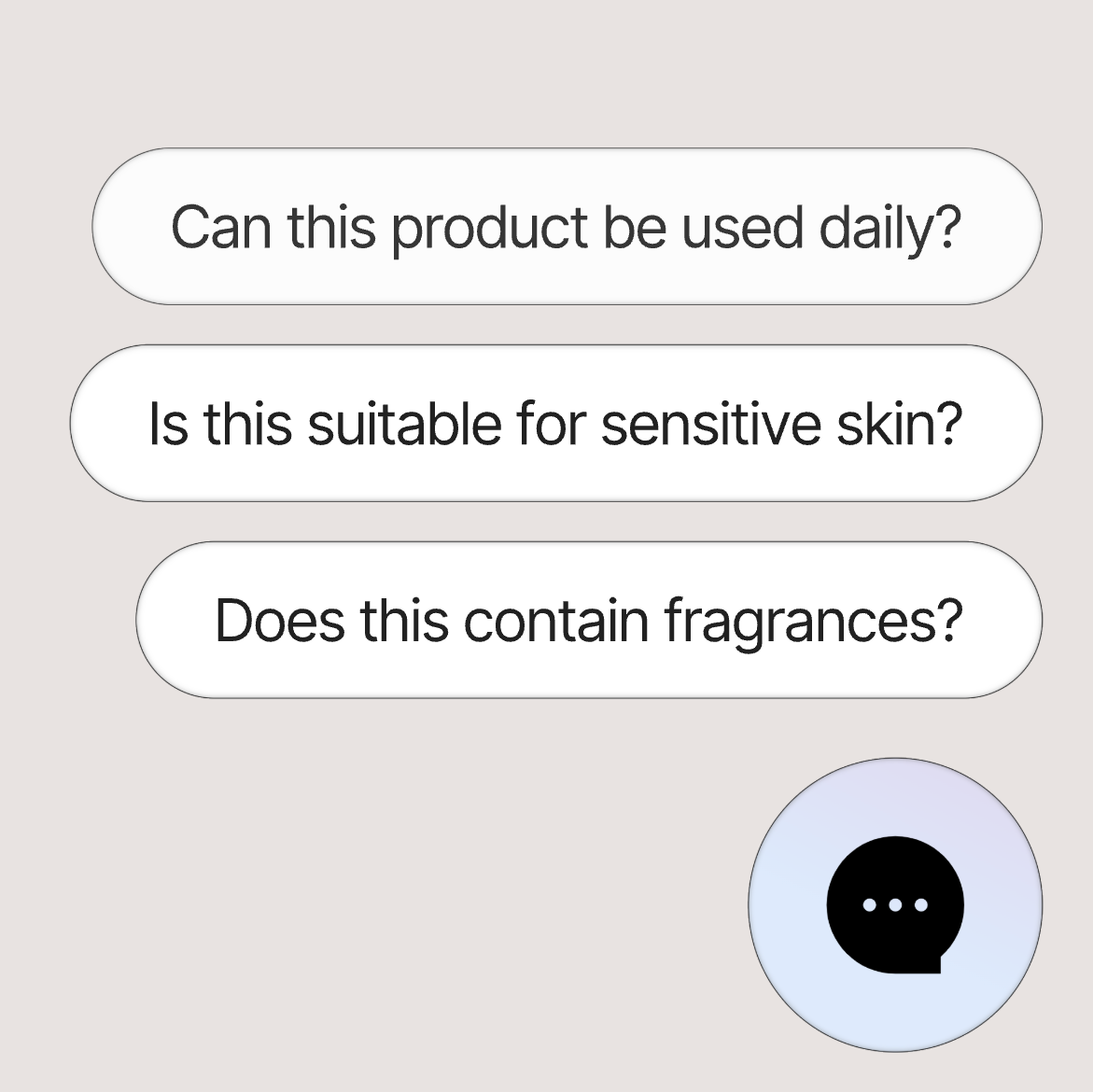
5. Aim to educate, reassure, or inspire — not just sell
Every small suggestion — a phrase, a button shape, a pause, a tone — creates what behavioral economists call a moment of micro-trust.
Individually, these moments may feel insignificant. But together, they turn a static interface into a relationship.
When greeting, choices, design, and timing align, conversation becomes the natural outcome — not the goal. That’s what conversational commerce gets right: it reframes success from “did they convert?” to “did they connect?”
For CX teams, this shift requires designing for the emotional continuity of the experience:
- Did each prompt respect the shopper’s autonomy?
- Did the interaction feel like a two-way exchange?
- Did the system adapt to intent rather than dictate it?
We love this example from Perry Ellis to drive this tip home:

Designing for trust in an age of AI
As AI continues to shape how people shop, brands face a choice: Design for control, or design for trust.
Suggestion is the path to the latter.
The right cue, delivered at the right time, reminds people that even in automated spaces, there’s still room for empathy and understanding.
Gorgias was built on the belief that great commerce starts with conversation, not conversion.
{{lead-magnet-2}}

AI Agent Keeps Getting Smarter (Here’s the Data to Prove It)
TL;DR:
- AI Agent is getting more accurate every month: It’s improved 14.9% this year thanks to better LLMs, constant updates, and user feedback.
- It writes more correctly than most humans: With a 4.77/5 language score, it’s nailing grammar, tone, and clarity better than human agents.
- It’s empathetic, too: AI Agent now shows more empathy and listens better than human agents.
- Brands are gaining confidence fast: Quality scores jumped from 57% to 85% in just a few months, and CX teams are noticing.
- Customers are almost as happy with AI as with humans: AI Agent’s CSAT is just 0.6 points shy of human agents’ average CSAT.
Handing trust over to AI can be intimidating. One off-brand reply and you undo the reputation and customer loyalty you’ve worked so hard to build.
That’s why we’ve made accuracy our top priority with Gorgias AI Agent.
For the past year, the Gorgias team has been hard at work fulfilling the pressing demand for accuracy and speed. AI Agent is getting smarter, faster, and more reliable, and merchants and their customers are happier with the output.
Here’s the data.
{{lead-magnet-1}}
AI Agent delivers more accurate answers than ever
This year, AI Agent’s accuracy rose from 3.55 to 4.08 out of 5, a 14.9% improvement from January. This average score is based on CX agents' ratings of AI Agent responses in the product, on a scale of 1 to 5.

In the past year, we’ve improved knowledge retrieval, added new integrations, expanded reporting features, and asked for more feedback in-product.
We saw the steadiest leap in July, right after the release of GPT-5. AI Agent began reaching levels of consistency and accuracy that agents could trust.
AI Agent writes with more linguistic precision than humans
Clear, easy-to-understand language helps people trust what they’re reading. Website Planet found that 85% more visitors bounced from a page when typos were present. That’s why we’ve made it a priority for AI Agent to respond to customers with correct grammar, syntax, and tone of voice.
The efforts have paid off: AI Agent scores a high 4.77 out of 5 in language proficiency compared to 4.4 for human agents. The result is error-free messages that are easy to read and consistent with your brand vocabulary.
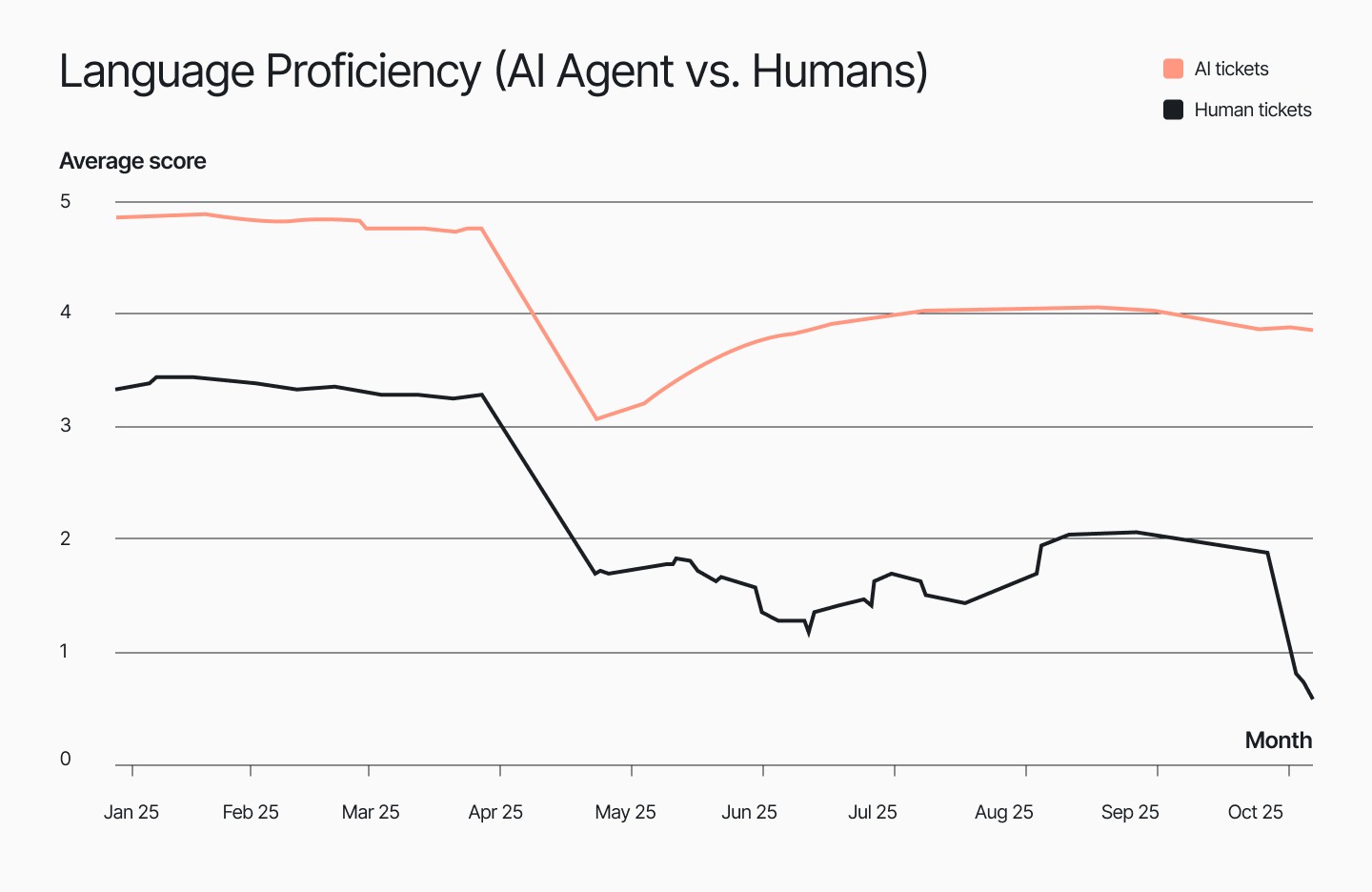
AI Agent shows that empathy can be scaled
Accuracy isn’t just about saying the right thing; it’s also about how a message lands. For that reason, we track AI Agent’s communication quality. Did it reply with empathy? Did it exhibit active listening and respond with clear phrasing?
Recently, AI Agent is even scoring slightly above humans with 4.48 out of 5 in communication, compared to 4.27. This means AI Agent captures the nuance of every message by considering the background context and acknowledging customer frustration before it gives customers a solution.
AI Agent resolves every part of a customer’s question
What happens when a ticket ends without a clear answer? Customers feel neglected and leave the chat still unsure. This can make your brand look out of touch, leaving customers with the lingering feeling that you don’t care.
But don’t worry, we built AI Agent to close that loop every time: AI Agent’s resolution completeness score sits at a perfect 1 out of 1, compared to 0.99 out of 1 for human agents.
In practice, this means customers feel cared for and understood, while your team receives fewer follow-ups, giving them more time to focus on strategic, high-priority tasks.
Read more: A guide to resolution time: How to measure and lower it
Brand confidence is on the rise
Building a great product is a two-way conversation between our engineers and the people who use it. We listen, review feedback, ship changes, and measure what improves.
From January to November 2025, AI Agent quality rose from about 57% to 85%. August was the first big step up, and September kept climbing. Brands are seeing fewer low-quality or incorrect answers and more steady decisions.
This is proof that merchants and their shoppers are witnessing the improvements we’ve been making, for the better.
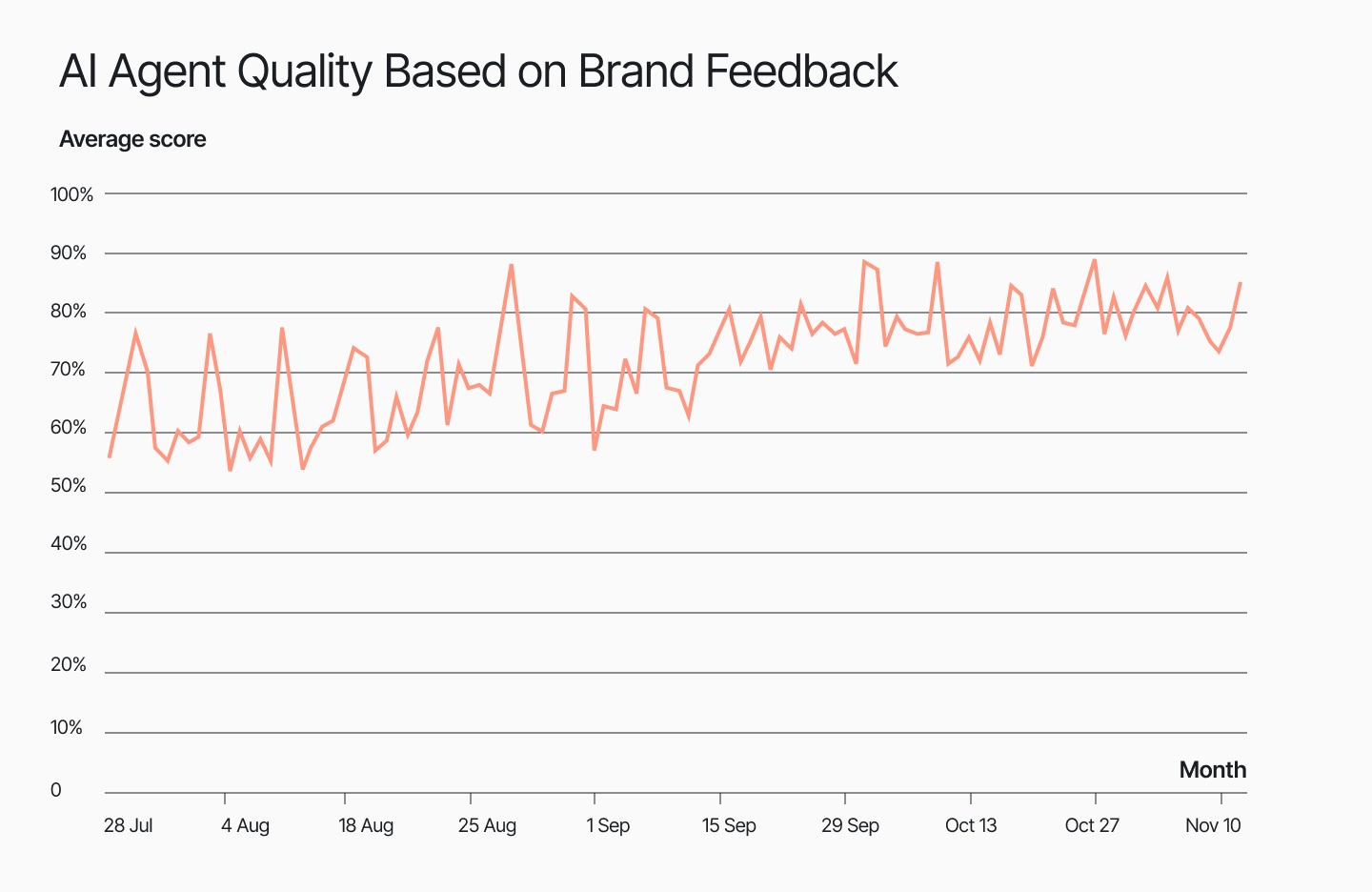
Related: The engineering work that keeps Gorgias running smoothly
Shoppers are rating AI support almost as high as human support
At the end of the day, what matters is how customers feel when they talk to support. Do they trust the answer? Do they find it helpful? Are they running into more friction with AI than without it?
Our data shows that customers are appreciating AI assistance more and more. Since the start of 2025, AI Agent on live chat has gotten a CSAT score 40% closer to the average CSAT of human agents. For email, the gap has narrowed by about 8%.
The goal is to eventually achieve a gap of zero. At this point, AI’s support quality is indistinguishable from that of humans. To get there, we’re focusing on practical improvements like accuracy, clear language, complete answers, and better handoff rules.

How we measure CSAT gap: The CSAT gap is calculated by subtracting AI CSAT from human CSAT. When the number is closer to zero, AI is catching up. When it’s negative, AI is still below human results.
Reliable AI interactions start with accuracy
Behind every accurate AI reply is a team that cares about the details. AI Agent doesn’t make up answers—it follows what you teach it. The more effort your team puts into maintaining an up-to-date Help Center and Guidance, the better the customer experience becomes.
As we look ahead to 2026, we’re focused on fine-tuning knowledge retrieval logic, refining Guidance rules, and continuously learning from feedback from you and your customers.
We’re proud of the strides AI Agent continues to make, and can’t wait for more brands to experience the accuracy for themselves.
Want to see how AI Agent delivers exceptional accuracy without sacrificing speed? Book a demo or start a trial today.
{{lead-magnet-2}}

AI in CX Webinar Recap: Turning AI Implementation into Team Alignment
Further reading

Reduce Customer Effort with AI: A Smarter Approach Than Surprise and Delight
TL;DR:
- Loyalty comes from ease, not delight. Simplifying customer support drives more loyalty than going above and beyond to surprise customers.
- High-effort interactions hurt loyalty. Long, complicated support experiences can push even satisfied customers to competitors.
- AI reduces customer effort. AI can automate simple tasks like FAQs, personalizing support, and order modifications, so your team can handle more complex tasks.
- AI enhances human support. AI works best when it complements your team by handling repetitive tasks.
For years, businesses have chased the idea that delighting customers is how to earn loyalty. The belief is simple: go above and beyond, exceed expectations, and customers will come back.
However, research from The Effortless Experience, a best-selling customer service book by Matthew Dixon, shows that this approach might be wrong. Focusing on customer delight often makes the experience more complicated and less efficient.
Most businesses aim to wow customers, but trying too hard leads to longer customer support interactions and higher costs. The real key to customer loyalty is making things easy.
Below, find out how AI is another string to your customer support bow, allowing you to increase speed and reduce effort while maintaining your brand's empathetic voice.
{{lead-magnet-1}}
Why doesn’t customer delight drive loyalty?
When customers reach out with a problem they want a prompt solution––90% of customers say an “immediate” response is important.
Delight is a problem when it adds additional steps and doesn’t solve the problem upfront.
Customers don’t want a solution with all the bells and whistles. They simply want to solve the problem ASAP.
There’s a disconnect between satisfaction and loyalty
It’s a common misconception that satisfied customers are loyal customers. But the numbers tell a different story. Research shows that satisfaction doesn’t always lead to loyalty.
In fact, 20% of customers who say they’re satisfied with a service still plan to switch to a competitor. Satisfaction alone isn’t enough to keep customers from exploring other options.
High-effort experiences put customers off
High-effort experiences are a major driver of customer disloyalty. Studies show that 96% of customers who encounter high effort interactions become disloyal.
When customers feel like they have to jump through hoops to get help, they’re more likely to take their business elsewhere.

Read more: Why you need to monitor customer effort score (& how to do it)
It’s easier to trigger disloyalty than loyalty
Negative experiences are much more likely to leave a lasting impression. Even when customers feel satisfied with the products, high-effort experiences can negatively impact loyalty.
For example, a customer may contact customer service due to a minor issue, such as a shipping delay. However, they may have to wait a long time to get a response or repeat their issue to multiple agents. Even if the issue is eventually resolved, they will leave frustrated and less likely to return.
If you need to put in extra effort, even positive interactions will fall short.
Bonus track: High-effort experiences are expensive
Trying to delight customers might sound like a winning strategy, but it often comes with a hefty price tag. Offering freebies, bending rules, and making special exceptions can increase your operational costs significantly. When these additional costs don’t contribute to customer satisfaction or loyalty, it’s important to evaluate if they’re worthwhile.
Read more: The hidden power and ROI of automated customer support
Simplify, don’t surprise: How can AI help reduce customer effort?
Several common issues make customer support a hassle. Some of the biggest culprits are multiple contacts to resolve a single issue, having to repeat information, and being transferred from one agent to another.
You can solve these common customer complaints with AI.
But won’t AI make my brand sound robotic and devoid of human touch?
Our hot take is that AI actually frees up your team to focus on more valuable tasks.
For example, RiG’d Supply, a brand specializing in off-road vehicle accessories, is letting AI handle some of the repetitive work so they can do better customer service. As a small team, even the CEO occasionally jumps in to keep up with the repetitive daily requests.
“This isn’t a matter of eliminating jobs, but giving our employees their primary jobs back. We get more bandwidth back to be able to take phone calls and hear how we can help you have the best possible experience on your next ramble,” says Luke Wronski, CEO of RiG’d Supply. “Our hope is to have AI give us the time back to have a conversation with you about the stuff that keeps us stoked to do what we do.”

Read more: Our AI approach: Onboard, automate, observe, and coach
5 AI strategies to minimize customer effort
Don’t get us wrong, AI can’t handle every moving piece of your customer support. So don’t assume you can replace your whole support team with AI. You still need high-quality human support for more complex tasks.
But if you have a solid support team that provides top-quality customer experience, you already have the right foundation to benefit from AI.
1. Automate frequently asked questions
AI tools are excellent at resolving simple customer queries, such as “Where is my order?” or “How much is delivery?” on the first contact.
Quick, accurate responses lead to a smooth experience and less effort from both sides. Customers no longer need to follow up multiple times for the same issue. Plus, you’ll save time that your support team can use for more complex issues.
Consider using an automated customer experience platform with an AI assistant. For example, Gorgias AI Agent automatically responds to FAQs like “How much is shipping?” or “When will my order arrive?” in your brand’s voice. For more technical requests, it assigns them to the right agents.
Read more: What's the secret to reducing WISMO requests?
2. Personalize support
AI can analyze customer data to deliver personalized suggestions. For example, if a customer frequently orders the same product, AI might recommend a subscription service to save them time and effort. Or if a customer has ordered several cooking utensils from the same product line, AI might suggest matching pans to complete their set.
💡Pro Tip: Find a CX platform with AI that offers custom, human-like responses. You can program your AI Agent to respond in different tones — friendly, professional, playful, or empathetic — so it feels more like your brand and less like a robot.

3. Provide guidance for next issue-avoidance
Imagine solving your customers' problems before they even know they have them — that’s next-issue avoidance. With AI, you can recall past interactions and customer habits to anticipate their needs.
If a customer has had issues with a product before, AI could suggest a protection plan upfront, saving them from future headaches. Your AI solution should help you stay one step ahead so customer support remains smooth and customers are happy.
Some AI assistants can even learn specific instructions or “Guidance” for handling certain topics. For example, you could create a Guidance instructing the AI to request photos if a customer reports a damaged product. If the AI detects that photos are already included, it automatically escalates the ticket to a human agent.
4. Automate order edits
AI’s capabilities shouldn’t end at answering FAQs. AI can also handle routine tasks like address changes or order modifications so your team can focus on issues that need more technical problem-solving.
Speedy resolutions keep customers happy, and as long as the issue is resolved efficiently, they care more about the result than who handled it.
For example, brands using Shopify can use Gorgias AI Agent to cancel orders and update shipping addresses without manual intervention from agents — so agents can dive into more complex requests that need their expertise, like upselling or resolving negative customer feedback.

5. Answer customer concerns with AI recommendations
Let’s face it—nobody wants to jump through hoops to get help. AI-powered helpdesks dig into customer interactions to find out where things get sticky and offer smart suggestions to improve the process.
For instance, AI might notice that customers are often confused about how to download and print the shipping label to return items. With this insight, you could make it easier and faster for customers to find and print the correct label.
Gorgias AI Agent goes a step further by detecting your customers' top concerns and allowing you to create knowledge base articles about them automatically. Brands can use this data to update their Help Center and FAQs, make key webpages more visible, and enhance product pages, ensuring customers find the answers they need quickly and easily.

Embrace effortless customer experience with AI
Customer loyalty isn’t won with flashy gestures. Instead, brands earn it by making things easy. AI is your best friend here, helping you streamline interactions, solve issues before they even arise, and keep customers in the loop without them having to chase down information. Remember, AI is there to enhance an already solid customer experience foundation and to help your team.
It’s time to rethink how you approach customer support. With AI, you can craft a seamless, low-effort experience that satisfies customers and turns them into loyal fans.
Book a demo to see how Gorgias can eliminate customer effort.
{{lead-magnet-2}}

Why Campaign Timing Matters: 4 Ways to Get it Right
TL;DR:
- Launch onsite campaigns at the right time to meet customer needs. For example, start a campaign when customers look at a sizing guide.
- Avoid using chat campaigns without a goal. Invite dialogue while addressing specific customer concerns.
- Educational campaigns help customers make better choices. When done at the right time, they can increase sales by 31%.
- Offering premium options on entry-level product pages can help engage customers and drive upgrades.
Without strategic planning, campaigns become nothing more than annoying pop-ups. But done right, onsite campaigns can energize customers to checkout and click the ‘order’ button.
At CX Connect 2024, TUSHY’s Senior Director of Customer Experience, Ren Fuller-Wasserman, and Connor O'Malley from Gorgias shared how vital timing was in creating successful Gorgias Convert campaigns.
You can also watch the full Why Education Matters for Conversions panel discussion below:
How campaign timing impacts customer engagement
Launching a message too early or too late can end in two ways: engaging a potential customer or losing them entirely. Timed perfectly to align with your target audience, you have a better chance of converting them.
Essentially, you want to be in the right place at the right time.
Connor O’Malley, a Gorgias customer success manager who helps brands optimize their Convert campaigns, said that it’s effective to solve a pre-sales friction point at the right time. “If we're going to have a campaign on the website and we want people to actually read it and feel compelled to engage with it, timing is everything.”
So, how do you resolve presale friction points with campaigns, all while getting the timing right? There are a few ways:
- Engage new customers with educational campaigns.
- Address customer concerns by initiating chat campaigns.
- Upsell to the appropriate customers based on customer behavior.
- Analyze your ticket history and metrics.
Now, let’s look at how you can launch these campaigns effectively:
1. Capture new customers with educational campaigns on product pages
Customers navigating your store might need help determining which option to choose or how your product works.
Don’t let them leave with unanswered questions.
Instead, offer them exactly what they need while they view a product, like a video tutorial, compatibility guide, or even an invitation to chat with one of your agents.
It’s about giving them the clarity they need to:
- Learn about your product
- Increase brand awareness
- Motivate them to explore the rest of your offerings

“The engagement rate on our education campaigns was much higher than any other campaigns we've seen, even upsell or exit intent campaigns,” Ren said. More impressively, their educational campaigns led to a conversion rate of 31%.
2. Answer customer concerns with chat campaigns
Brands miss the mark when they only use onsite campaigns as a bridge to their live chat channel.
You might even be one of them with one of these conversational campaigns on your website right now:
- “Let us know if you have any questions!”
- “Need help? Talk to an agent now!”
While there’s nothing wrong with using campaigns to get one-on-one time with shoppers, it casts too wide a net to truly capture customers’ attention.
“We were just asking, "Let us know if you have any questions. Here's the chat," and that’s not really compelling people to ask their questions, even if they did have some,” Connor said.
The fix? Use customer concerns to guide your chat campaigns and bake them right into your campaign messaging.
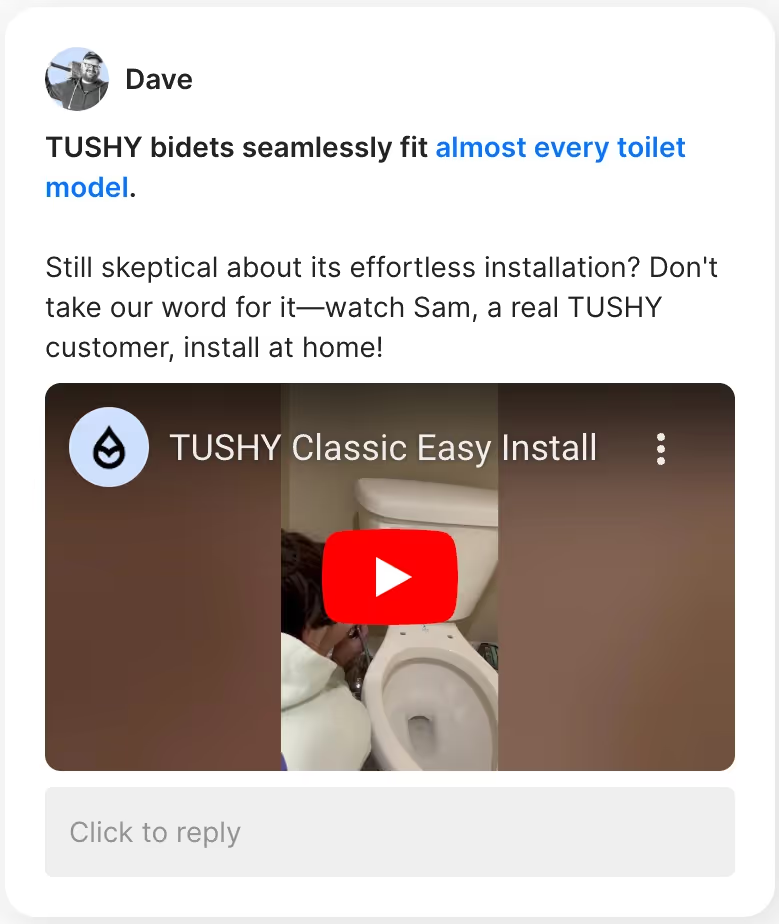
Here are pages that could benefit from chat campaigns:
- Compatibility/quiz page: Accelerate decision-making and alleviate concerns by activating a campaign on pages where customers are exploring product compatibility, taking a quiz, or checking sizing guides.
- Product comparison page: Trigger a chat campaign when customers are comparing similar products to help them understand differences and guide them toward the best choice.
- Checkout page hesitation: Engage customers who linger at checkout with a chat offering to clarify any last-minute concerns, such as shipping details or return policies, to help push them over the finish line.
💡 Pro Tip: Offer real-time support during peak traffic hours to catch customers when they’re most available.
“People fall in love with TUSHY through these real-time conversations. We talk to everyone like our best friend, and that is what drives people to consider making this life switch.”
—Ren Fuller-Wasserman, Senior Director of Customer Experience at TUSHY
3. Upsell items on entry-level product pages
Upselling to new customers can be effortless if you present your higher-ticket items as better options, as Ren does.
TUSHY has multiple bidet models, ranging from a basic model called Classic to one with a temperature-controlled seat. Ren uses their entry-level bidet product page to launch an upsell campaign aiming to educate and upsell simultaneously.
“We want customers to have the insertion at the right moment. They’re on our Classic page. Great, did you know you could get hot water? We pop the campaign up for our Spa 3.0.”

4. Find the perfect timing by analyzing your metrics
We’ve given you general recommendations on when to deploy your onsite campaigns, but your campaigns should go beyond these general campaigns.
The best information for finding your perfect timing? Your tickets.
Tickets are a record of customer sentiment — your cheat sheet to find out what customers want to know and their exact concerns.
“If you can look at your analytics, you can target what the average site traffic spend is on a particular page. That’s the sweet spot you want to shoot for,” Connor said.
On Convert, you can tailor campaigns to display only when customers meet certain conditions. Some conditions you can customize are current URL, time spent on a page, products in cart, number of visits, total spent, and more.

💡 Pro Tip: Analyze traffic for each of your webpages and think about the reasons behind the metrics. Why are website visitors spending more time on one product page than another? Why do visitors drop off after viewing certain pages? Understanding these patterns allows you to alter your campaigns to address specific concerns.
Get your timing right with Gorgias Convert
Effective campaigns depend on delivering the right message at the right time. Focusing on presale friction points, carefully timing your outreach, engaging in valuable conversations, and providing educational and upselling content when it’s most relevant can help you reach your conversion goals.
Ready to see how Gorgias Convert optimizes your campaign timing? Book a demo today and flip customer interactions into brand advocacy.
{{lead-magnet-1}}

A Complete Guide to Black Friday Ecommerce in 2025
TL;DR:
- Start BFCM prep now to capture more revenue and loyal customers. Early planning helps you launch high-converting campaigns and get your support team ready before the rush.
- Update your returns, shipping, and lost package policies. Make these policies visible and self-serviceable to boost trust and reduce support tickets during peak traffic.
- Automate support to protect your team’s time. Use AI tools like Gorgias to deflect FAQs and focus human agents on high-impact tickets.
- Build BFCM campaigns with social media, influencers, and SMS. Create content that highlights your deals, promote top posts, and offer early access to subscribers.
- Recover carts and re-engage new customers post-BFCM. Set up chat widgets, SMS/email automations, and follow-up campaigns to turn browsers into repeat buyers.
One month ahead of Black Friday and Cyber Monday, and shoppers have already managed to spend $88.6 billion online, according to Adobe.
But it takes a coordinated effort by customer support, sales, and marketing to encourage a shopper to click “checkout.” Without a solid ecommerce strategy in place, many online retailers will miss out on the Black Friday and Cyber Monday rush.
Whether you’re looking to optimize your existing strategy or starting from scratch, we’ve got you covered. This guide will help you make the most out of your BFCM ecommerce strategy with a clear list of steps (in chronological order) to help you prepare.
{{lead-magnet-1}}
What is Black Friday, Cyber Monday?
Black Friday, Cyber Monday — also referred to as BFCM — are two back-to-back sales days that bring in a ton of revenue for both in-store and ecommerce retailers in the US. The Black Friday - Cyber Monday shopping window also kick-starts holiday shopping from Thanksgiving day through the new year.
Why you need to prepare for BFCM now
BFCM isn’t just about one big day of generating revenue. It’s a crucial period for online retailers to capture new customers and convince them to keep shopping through the end of the year and beyond.
In-person BFCM experiences are out and ecommerce is in
Shopper sentiment is shifting away from physical experiences. Online transactions are up by 8.2% year-over-year. So, you probably won’t see consumers camping out in front of physical stores on Black Friday, but those same shoppers still want to find a great ecommerce deal.
Consumers are eager to spend, despite concerns about inflation
According to research from Nielsen, the desire for a good deal caused 41% of shoppers to spend more in 2023 than they had the year prior.
Brand loyalty is out — unless given a reason to commit
Shoppers, Gen Z in particular, are willing to buy “dupes” from alternative brands for a cheaper price. That's why building brand awareness well before BFCM is crucial — you need shoppers to know and trust you before the sales frenzy begins.
Get proactive rather than reactive
When you make a plan early, you give your business more time to craft a great marketing campaign. Plus, you give your team time to figure out how to manage customer service on Black Friday for these high-traffic days.
Considering Black Friday, Cyber Monday is the busiest ecommerce sales event of the year, prepare as early as possible to get a leg-up and stay on top of Black Friday trends.
Related reading: Why proactive customer service is essential for growing your business
Pre-Black Friday preparation: What to do before the holidays
Preparing for Black Friday — and building a strong ecommerce strategy — goes well beyond ironing out a limited-time deal.
Tactics like updating key policies, building out customer self-service options, and marketing early will help you be successful.
1. Update key policies on your website before BFCM
Displaying clear-cut and easy-to-find policies on your website makes a huge difference to a customer’s user experience. It sets the customer up for success and cultivates a positive sentiment with your brand.
To prepare for the best Black Friday-Cyber Monday possible, we recommend updating these key policies (and your FAQ page) with BFCM-related information:
- Returns & exchanges: Expect more gift returns and exchanges. Use return apps like Loop Returns to create a self-service portal and connect it with Gorgias so AI Agent can automatically send customers their return link or status update.
- Shipping & fulfillment: Be upfront about processing times, estimated delivery dates, and tracking options. Shoppers buying gifts expect fast and reliable delivery. Transparency here prevents frustration and ticket spikes.
- Lost packages: More shipments mean more chances for loss or delays. Make sure your policy explains whether you cover damages, refunds, or credits. Include this in your FAQ so customers (and your support team) know exactly what to expect.
Related reading: FAQ Page template & tips (+ free Shopify FAQ generator)
2. Reduce strain on your customer service team
Turns out, a lot of the customer support inquiries your team receives are repetitive.
“If you force agents to respond to every question manually — no matter how small — you're only limiting the time they can spend on tickets that actually need human attention,” says Gorgias Senior Director of Customer Success, Bri Christiano.
That’s the reason we built AI Agent at Gorgias: It deflects your most repetitive tickets — up to 60% of your overall ticket volume — so you can focus on the tickets that grow your business.
Orthopedic shoe retailer Orthofeet leaned into Gorgias’s AI to support customer service interactions. Not only did the brand gain a streamlined way to manage customer feedback, they also saw response time shrink from 24 hours to 35 seconds on email.
3. Build a marketing campaign to tap into social commerce
Social commerce is on the rise among consumers worldwide.
Sprout Social reports that one-third of shoppers in the UK make spontaneous purchases based on social media a few times per year. And that number is expected to rise as shoppers complete their holiday shopping during BFCM.
You don’t necessarily have to sell directly through Instagram, but you can leverage your social channels to generate brand awareness.
The need for social-focused customer support is exactly why online retailer MNML turned to Gorgias. The company found that their shoppers turned more and more to social media for answers to their shopping-related questions.
Ultimately, the company leveled up their customer support on social media to connect with potential buyers.

Blanking on BFCM campaigns? Here are some effective marketing campaign ideas:
- Partner with micro-influencers to generate brand awareness. Don’t partner with influencers for the sake of it. Think about it like building a relationship with someone who fits your brand ideals who can cross-sell your products to their audience. Look for a creator with less than 100,000 followers who have audiences that match your target audience.
- Create content around your Black Friday deals. Highlight your deals using creative content. Collect photos, videos, or illustrations of your products. Then, draft copy for captions, think through the best hashtags, and hand over creative briefs to your design team to build any assets you might need.
- Put a little money behind your most successful organic social media posts. The weeks or months leading up to BFCM are prime time to talk about your brand’s Black Friday promotions. Use social media analytics to see which published posts across your channels are performing the best. Even with a small budget, you can use social ads to grab even more eyeballs — and potentially bring more people to your website.
- Prompt customers to sign up for SMS alerts on mobile. Through these notifications, you can give early sale access to subscribers and incentivize new shoppers to build a deeper relationship with your brand.
How to maximize BFCM revenue in 2 steps
Imagine Black Friday, Cyber Monday is here. Even better, imagine you’ve got a ton of website traffic full of eager browsers. You need a plan to keep those browsers engaged.
One major step you can take to boost your conversion rate and potential revenue is to increase communication touch points and focus on recovering abandoned carts.
1. Increase customer touchpoints to keep shoppers engaged
Throughout any customer’s journey, there are many opportunities to interact with your brand. One moment might be finding out about your BFCM sale on social media, signing up for emails to get early access, or browsing the best deals before heading to checkout.
The more you interact with customers along the way, the more you can keep them engaged — and personalized interactions increase your chances of converting a first-time shopper into a repeat customer.
One way to do that is with Gorgias Shopping Assistant, an upselling tool that uses conversational AI to personalize the customer's buying journey. It offers several ways to boost overall engagement:
- Customer-specific product recommendations
- Upselling products during high-intent moments
- Offering discounts to ease customer hesitation

2. Reduce abandoned carts
Cart abandonment is a major source of lost retail sales for any ecommerce business, considering about 70% of online carts are abandoned.
You can easily target customers who have opted into an email list or receive SMS messages from your brand. Design emails or text messages designed to trigger if a cart is abandoned.
Include copy that builds a sense of urgency to drive customers back to their shopping carts to “buy now” before the deal is over.
There’s even a chance to use re-engagement to increase your average order value by upselling once that customer returns to your site.
How to retain new customers you get during BFCM
Repeat customers are valuable — like, really valuable.
According to Gorgias research, returning customers make up about 21% of a brand’s customer base but generate 44% of that same brand’s revenue.
Your brand should re-engage with anyone who shops on your website during the BFCM rush. Those same people could become returning customers who give your shop a revenue boost during the rest of the holiday season.
1. Offer a discount for next time
The perfect moment to re-engage a customer starts at checkout. When someone makes a purchase through your online store, offer them an immediate discount that goes toward their next purchase.
At CX Connect LA 2024, Ron Shah, CEO of Obvi, shared his brand’s strategy for offering discounts to generate revenue. Ron knew implementing AI to support Obvi’s two-person customer support team was necessary to help the brand grow without eliminating the need for his human agents.
“The time saved by AI handled a lot of the redundant work our agents were doing, which meant we could turn them into part-time sales agents. We also gave them a code to help them prevent a refund from happening or upsell somebody. It created a completely new shift in their mindset. They realized, ‘Oh wow, you're not just taking something away from me (with AI) — you're actually elevating my opportunity.’”
Tip: You can increase the touchpoints to re-engage with an existing customer by building a reminder email that triggers one week after their initial transaction. That way, you not only stay at the top of their inbox, you also stay top of mind.
2. Invite customers to join a loyalty program
Loyalty programs are a tried-and-true method to build engaged, returning customers.
In a recent survey, Yotpo found that over half of surveyed consumers agreed a loyalty program would encourage them to purchase more from a brand.
If you already offer a loyalty program, make sure new customers know about how to get the VIP experience with your store. Build awareness touchpoints into your loyalty program marketing strategy. You can also prompt buyers to become loyal customers after they make their first purchase.
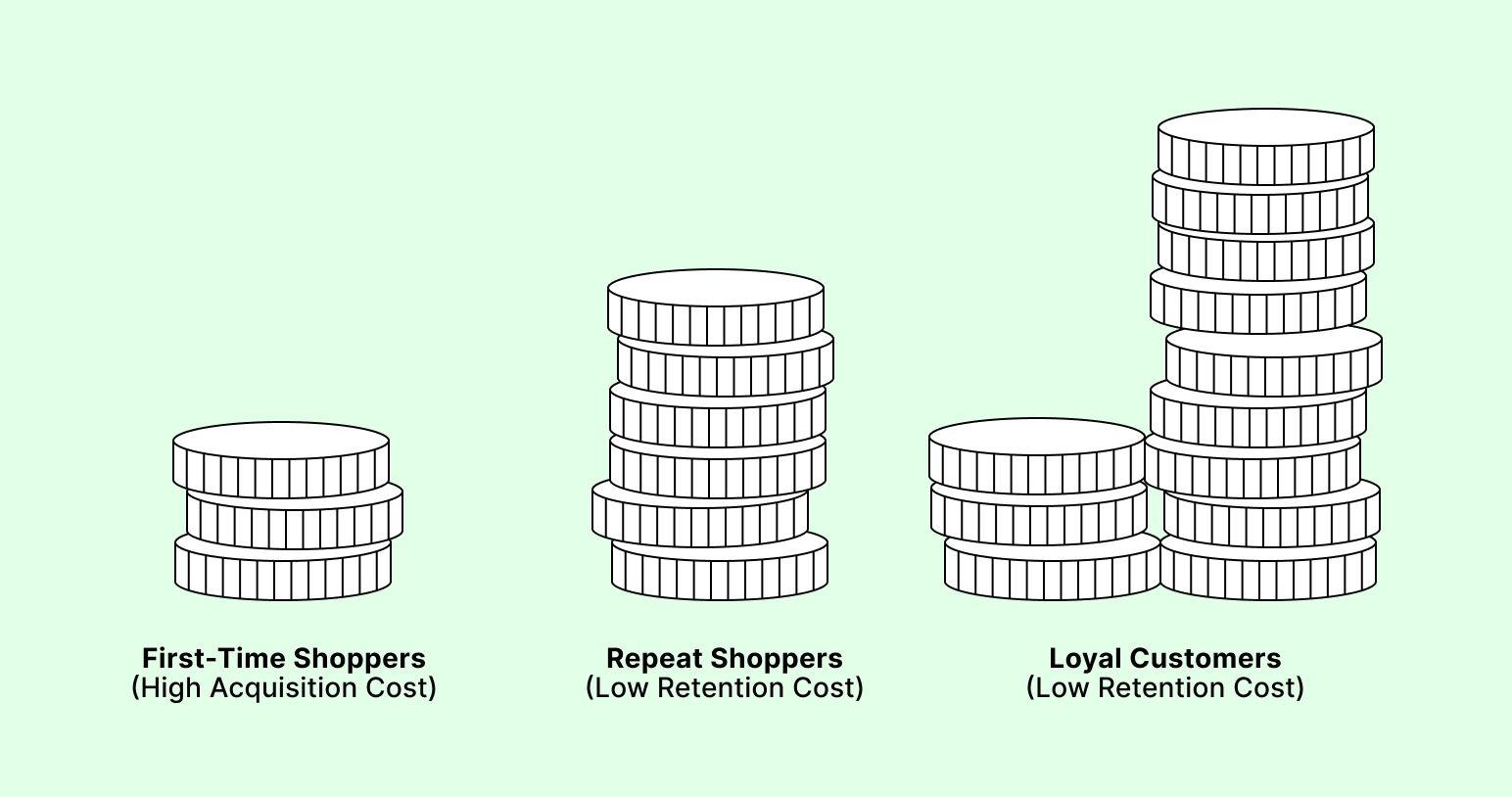
3. Continue to improve your customer experience strategy
A successful, positive, and repeatable customer experience doesn’t end after midnight on Cyber Monday. It’s a road rather than a destination.
Consumer habits are always changing, and your support teams must be prepared to handle customer requests.
One way to anticipate your customer’s pain points is to look at customer feedback.
Reviews and social media activity is a great place to start. You might also consider putting a more formal customer sentiment strategy in place, with a CSAT survey to collect direct feedback from customers.
This feedback helps your team prioritize what needs to improve so you’re not left reaching in the dark.
Give your ecommerce strategy a boost this holiday shopping season
The name of the game this Black Friday - Cyber Monday isn’t just to get a ton of online sales; it’s to set up your ecommerce site for a successful holiday shopping season.
Success could look like:
- A reduction in BFCM returns or exchanges
- Having the perfect amount of inventory
- Seeing higher-than-average sustained engagement on your social channels
If you want to move the meter, focus on a strong Black Friday marketing strategy that starts now.
Gorgias is designed with ecommerce merchants in mind. Find out how Gorgias’s time-saving automations and convenient platform can help you create successful customer experiences.
Claim your demo today, or sign up to try Gorgias.
{{lead-magnet-2}}

How to Automate Half of your CX Tasks
TL;DR:
- Automating CX tasks improved Shinesty’s support performance. They cut resolution time by 50% and raised satisfaction scores.
- They focused on high-impact, repetitive inquiries first. WISMO, subscriptions, and account questions were easy wins.
- Automation didn’t kill their brand voice. Smart help articles and custom AI responses kept things on-brand.
- Their small team got more specialized. Freed from repetitive work, agents now handle complex, high-value conversations.
Customer expectations continue to rise — around 82% of service pros say customers expect their requests to be resolved in less than three hours. Given the pressure to meet these climbing demands, more brands are turning to automation and AI.
It’s not only about providing a fast, helpful, and efficient customer experience. Brands must also stay ahead of the competition and adopt the latest tech for long-term success.
Luckily, brands like Shinesty are adopting tech like AI and automation to meet consumer demands. It’s worth it — since adopting automated CX in 2023, Shinesty’s resolution time has decreased by 50%, and their overall satisfaction rate is up.
In a recent workshop, Molly Wallace Kerrigan, the Marketing and CX Director at Shinesty, shared her team’s strategies for setting up automation, maintaining brand voice, and optimizing customer experience (CX).
You can also hear Molly share these insights herself by watching the workshop here:
How Shinesty automates more than half of their CX tasks
Before using AI Agent, Shinesty hired about 20 seasonal employees, including CX agents, to help with the peak holiday season. In 2023, they only hired two, bringing their total to five agents. It was clear that AI Agent saved them money.
“When AI Agent came along, it changed everything... We only hired two agents, raising our team from three to five. That was our biggest game changer with Gorgias.”
Molly shared their impressive journey to automating 54% of their CX tasks — a feat transforming their customer service operations, especially during high-demand periods like the holiday season. Most importantly, they achieved this without losing their brand’s personality.
Here’s how they did it:
Focus on key areas
First, Shinesty identified the most common customer inquiries that could be automated. They prioritized high-volume tasks such as WISMO (where is my order?), subscription cancellations, and account management. Automating these repetitive inquiries reduced the pressure on their human support agents.

Shinesty uses Flows in their Chat to answer frequently asked questions like “Do you have discounts?”
Rebuild and clean up
Before rolling out automation, Shinesty cleaned up its helpdesk. The team re-evaluated existing workflows, removed outdated processes, and ensured their helpdesk was ready for automation. Laying the groundwork helped the team transition to automation more efficiently.
Optimize self-service
A key part of Shinesty’s strategy was empowering customers to find answers on their own. Molly emphasized the importance of creating simple, humorous help articles that resonate with their brand. Regular audits of these resources meant customers could self-serve more easily, reducing the need for human intervention.

Shinesty’s Help Center provides customers with a quick way to self-serve.
Lean into AI recommendations
AI-powered Article Recommendations help Shinesty identify ways to improve their use of automation. For example, AI suggested updating some existing help articles based on common customer questions, helping Shinesty address gaps proactively.

With AI Agent, you can train AI to recommend the most relevant articles depending on a customer’s message.
Gradual scale-up
Instead of overhauling everything at once, Shinesty rolled out automation gradually. The team focused on key areas and then expanded. Eventually, they automated 54% of their CX tasks without overwhelming their team or compromising service quality.
Reinvest time into human agents
Automation doesn’t mean eliminating human agents. Instead of getting bogged down in repetitive tasks, their small team of agents now has the chance to focus on more valuable tasks and specialize.
“With a smaller team, we could develop our agents more, giving them opportunities to specialize in different areas. Our satisfaction rate has increased, and our resolution time has decreased by 50%.”
{{lead-magnet-1}}
Why you should embrace AI and stay ahead of the competition
Molly strongly encourages businesses not to hesitate when it comes to adopting AI tools. “Don't be afraid. Just do it. AI is here to stay, and it's not going anywhere,” she emphasized.
Integrating AI into your CX strategy allows you to keep up with customer demands and position your brand ahead of the competition.
📚 Related reading: The hidden power and ROI of automated customer support
Take the leap with AI for a competitive edge
Molly’s advice is clear: AI is a game-changer for businesses looking to stay ahead. The tools are intuitive, easy to implement, and designed to enhance your team’s capabilities rather than replace them.
Gorgias AI Agent comes with pre-built templates that make it even easier to get started. These templates provide a solid foundation, allowing you to quickly set up automated responses and workflows that align with your brand’s tone and style. Molly pointed out, “The templates were a great starting point, and the guidance part was simple.”
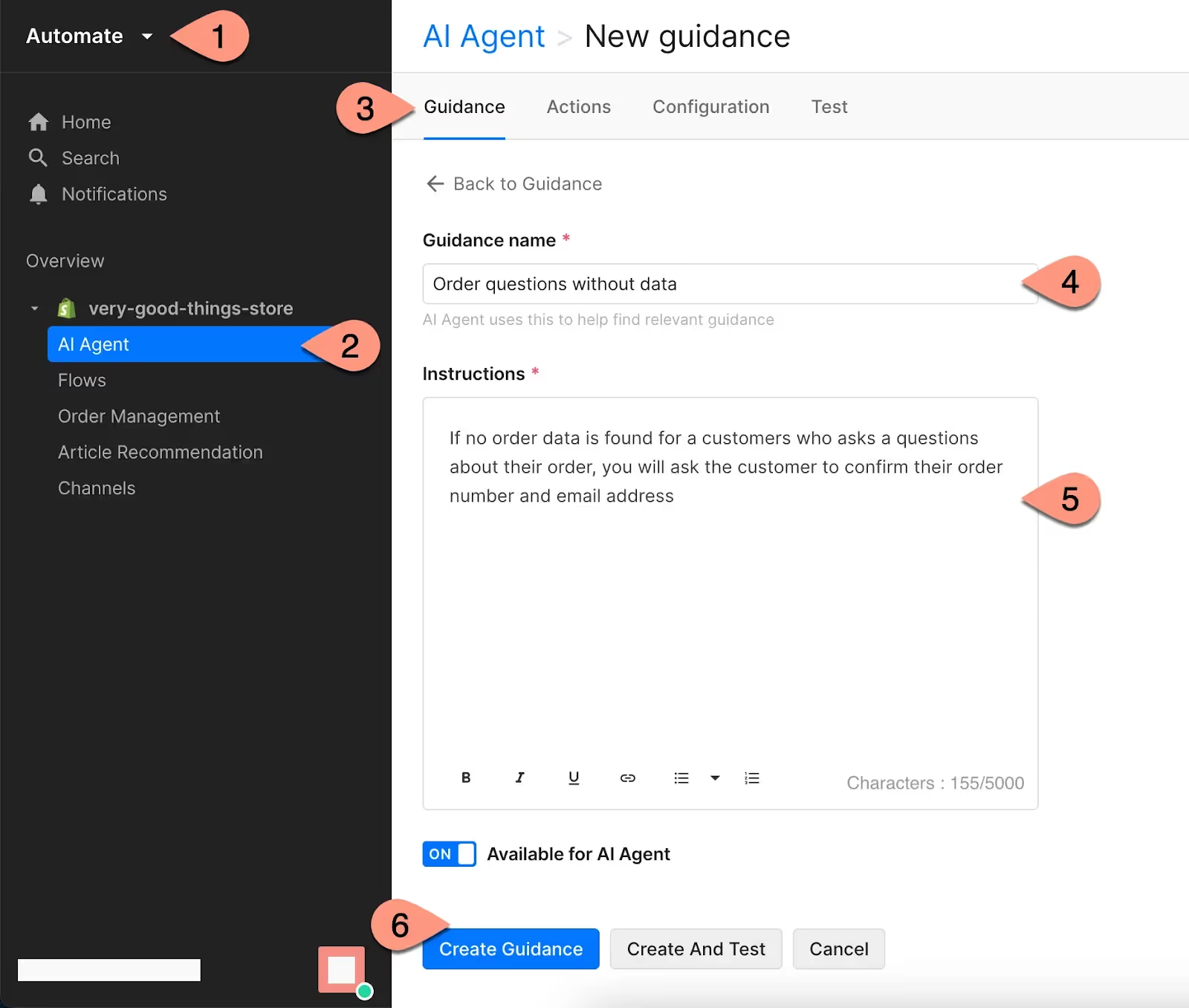
Control how Gorgias’s AI Agent responds to customers with custom instructions based on your best practices and internal policies.
By adopting AI, you can automate routine tasks and ensure consistent and empathetic customer interactions. Your team will also have more time to focus on more complex and valuable activities.
As Molly noted, AI allows your team “to develop beyond mindless tasks” and offers “empathetic responses without turning on the customer,” which can significantly improve customer satisfaction and loyalty.
Read more: How Shinesty automates 50%+ of tickets to offer great CX with a team of 5
The future is here with more AI Agent features
Looking to level up your CX automation? AI Agent has more exciting features, including the ability to perform actions like canceling orders or changing addresses automatically — tasks that currently require human intervention.
Another essential feature for CX teams is Auto QA, which enhances the quality assurance process by removing subjectivity and ensuring more consistent results.
Want to see how many routine tasks you can automate? Book a demo to see Gorgias AI Agent in action today.
{{lead-magnet-2}}

How Campaign Messaging Can Increase Conversions
TL;DR:
- Shoppers' attention spans are short, so your messaging needs to hit fast and resonate. Gorgias Convert helps brands launch personalized, timely campaigns that engage visitors and increase conversions.
- Personalization is key to winning over customers. Use tailored product recommendations, exclusive offers, and personalized messaging to boost order value and lower bounce rates.
- Educational and conversational campaigns build shopper confidence. Quick tutorials, quizzes, and live chat support reduce support tickets and help convert unsure visitors.
- Test your messaging to find what works best. A/B testing within Convert allows you to refine campaigns based on real data, helping you consistently capture more interest and drive purchases.
With so many distractions across platforms, it’s getting trickier to hold shoppers’ attention — even on your own website. You’re lucky to get even a couple of seconds of their time. But don't worry, we've got the perfect bait for your brand.
Gorgias Convert is specially designed to capture shoppers at the right time with the right messaging. This onsite conversion strategy tool launches subtle yet compelling campaigns, allowing ecommerce brands to engage customers like never before.
In this article, we'll dive into how you can refine your messaging to increase conversion rate, boost order value (AOV), reduce bounce rates with clever exit intent triggers, and educate customers through engaging quizzes and informative content.
Get ready to craft campaign messaging that truly connects and drives customers to buy.
{{lead-magnet-1}}
Why should you care about campaign messaging?
Compelling campaigns matter if you want to drive engagement and conversions. If your message doesn’t resonate with shoppers, they’ll exit without taking action.
Customize your content to your shopper's specific needs — it can make all the difference in capturing attention and winning over a new customer.
The top 6 ways to create captivating & compelling campaigns
Different goals call for different campaigns. Here are the top six methods to create compelling campaigns that resonate with your customers.
1. Put a face to your stories
Relatability is the magnet that pulls shoppers closer to considering your product. It’s why brands highly incentivize social proof like customer reviews and influencer endorsements.
Combine stories with social proof through relatable customer story campaigns or behind-the-scenes campaigns. When your customers see someone who genuinely enjoys your product, it nudges them one step closer to the checkout.
How STYLEST did it
Innovative swimwear brand STYLEST gives customers a VIP shopping touch with a campaign that shows their co-founder Chrissy talking about the benefits of their bras. For shoppers unaware of the brand, a firsthand account from the creator leads to a deeper connection to the brand’s mission and products.
STYLEST created a total of eight campaigns made for different scenarios and customers. At its peak, their campaigns drove 18% of the brand’s total revenue — a remarkable achievement since pop-ups typically influence only 2-5% of revenue.

2. Incorporate visuals
Plain text campaigns can be easy to gloss over. Instead, add visuals to your campaigns, like images, infographics, emojis, or videos, to easily break up text and capture attention.
However, make sure not to overload visuals or text with information. For instance, if you’re making a video tutorial, keep it short and on message. Meandering can cost you engagement.
How Kreyol Essence did it
Haircare brand Kreyol Essence’s welcome campaign is simple but eye-catching: a greeting with a sparkle emoji. Friendly language is a fantastic way to invite shoppers to connect with your support team and find what they’re looking for.
Kreyol Essence created welcome campaigns, product recommendation campaigns, and promo campaigns to lower the barrier to entry for new customers. In three months, they reached an incredible average conversion rate of 11.47% — 8% more than the industry benchmark.

3. Offer personalized product recommendations
According to 1,100+ survey responses, customers want personalized experiences. With product recommendation campaigns, you can deliver just that. Feature a selection of products to upsell and cross-sell in targeted campaigns, then choose which kinds of shoppers receive them.
Three effective scenarios to use product recommendations:
- For visitors viewing a specific product or collection: Suggest product bundles or add-on products that align with what they’re already browsing to increase purchase likelihood. For example, if someone is viewing a shampoo product page, a campaign can suggest a conditioner to go with it.
- For first-time visitors: Showcase best-sellers or trending products to new visitors, helping them discover items they might like.
- During seasonal sales: Feature related products in your holiday or special sale campaigns, promoting bundles or discounted add-ons to boost overall sales.

How LSKD did it
Australia-based sportswear brand LSKD puts eyes on their three newest products by appearing to shoppers with empty carts. This condensed list of recommendations makes buying easier for customers who don’t know where to start.

4. Provide incentives that are unique to the shopper
Give shoppers a reason to stay longer. Exit intent campaigns can be the last-ditch effort to retain customers who are about to leave. Make sure these campaigns are enticing, down to the selling point and message.
Here are the four essential elements to getting your campaign messaging right:
- Offer value: Provide an irresistible offer, such as a discount code or free gift, to persuade customers to stay. Convert enables users to select a generic discount code or a personalized, unique discount code, which can be more enticing and drive higher clickthrough rates (CTR).
- Highlight the benefits: Highlight what customers will gain shopping with you, like free shipping, discounts, or exclusive gifts on top of their order.
- Personalize the message: Customers like to feel seen. Use customer profiles (i.e., subscriber vs. not) or reference items they've viewed to make the offer more relevant.
- Keep it concise: Use clear, direct language and a strong call to action.
How Impact Dog Crates did it
Premium dog crate retailer Impact Dog Crates anticipates uncertain customers by allowing one free exchange per order. They show off this perk to browsing customers in just a couple of sentences — simple and effective.

5. Educate customers with fun, engaging material
Businesses win 28.9% more new customers when they implement customer education programs, according to Intellum.
For browsing shoppers, you don’t need a formal program, just a quick educational campaign that appears while they look through your products. Empowering shoppers with information about product knowledge can lead to better buying decisions and, in turn, decrease return rates.
Educational campaign ideas:
- Interactive quiz campaign: Do you have a product line for specific needs and customers? Point customers to your sizing guide or product matching quiz for a personalized shopping experience that helps them find exactly what they need.
- Informative blog campaign: Share educational advice through a campaign and link out to a relevant blog post.
- Product tutorial campaign: Do customers often struggle with using your product? Demonstrate how to use your products by including a short video tutorial in the campaign.
- Product comparison campaign: Provide a side-by-side comparison of your products to help customers choose the best option.
How TUSHY did it
TUSHY, a leading bidet brand, recognized that many customers were concerned about bidet installation, leading to a spike in support tickets and abandoned carts. Their solution is an educational video campaign that proactively guides customers through installation.
The campaign contributed to 25% of their revenue and a 37% drop in bounce rate. Most importantly, it cleared away installation anxieties and repetitive support inquiries and provided customers with a more confident buying experience.

6. Offer VIP support by having real-time conversations
Use conversational campaigns to show customers you're there to make shopping easier. Plus, personalized advice helps hesitant buyers make decisions.
Actionable tips:
- Offer human support: Ensure seamless integration with human agents for more complex questions and personalized assistance.
- Leverage AI Agent: If your support agents can’t handle the conversation due to business hours, leverage Gorgias’s conversational AI tool, AI Agent, to handle pre-sales questions.
How Glamnetic did it
Accessory brand Glamnetic lets customers know they can call for help anytime, just by using Chat. Quick access to a customer support agent is a simple way to alleviate customer concerns.
Glamnetic’s strategic use of Convert campaigns drove an 18.39% on-ticket conversion rate for their top exit intent campaign and up to 49% more sales for new product promotions. They even saw a 12% increase in average order value.

💡 Pro Tip: Unsure which message will resonate most with your audience? Use A/B testing to experiment with different messages, designs, or calls to action to see which version drives the best results. This data-driven approach takes the guesswork out of your content strategy so you can generate strong interest.
Get their attention with Gorgias Convert
Ready to take your campaigns to the next level? Gorgias Convert offers powerful tools to engage customers at the right moment with personalized, compelling messaging.
If you’re looking to boost conversions, reduce bounce rates, or offer VIP support, Convert makes it easy to create campaigns that truly speak to your audience. Start capturing attention and driving results today with Gorgias Convert. Book a demo now.
{{lead-magnet-2}}

How These Top Ecommerce Brands Respond to Difficult Customers
TL;DR:
- Start with empathy, especially in high-stakes situations. Understanding the emotional weight of events helps agents respond with compassion and urgency.
- Choose your battles wisely. Obvi defuses tension by letting customers keep the product while still receiving a refund, boosting goodwill and lifetime value.
- Trust and empower your CX team. Glamnetic’s agents are given autonomy to resolve issues creatively to avoid bottlenecks.
- Ask customers what went wrong. Jaxxon finds that asking for feedback directly can defuse angry customers and turn complaints into insights.
- AI can help turn negative experiences around. Tools like Gorgias AI Agent support these strategies by delivering fast, thoughtful service at scale.
Strategies for handling difficult customers can sometimes feel like vague, generalized advice. If you’re dealing with these types of customer interactions daily, you need specifics.
At CX Connect 2024 in LA, four leaders in the ecommerce and customer experience space shared their tips for managing demanding customers with empathy, strategy, and a dash of creativity.
In this panel recap, learn how leaders at Princess Polly, Obvi, Glamnetic, and Jaxxon navigate complex customer interactions while maintaining high levels of customer satisfaction.
Watch the full panel discussion:
Start from a place of empathy
Customer experience agents: The baseline is empathy, says Alexandria Collis, Senior Director of Operations at fashion brand Princess Polly. Having a reset point — empathy and understanding — can be valuable for agents to remember, especially in the middle of heated exchanges.
In particular, Alexandria points out that significant life events can be tricky because customers expect a high level of service. These milestones are often sentimental, coming with more emotional investment from the customer’s end than your run of the mill WISMO requests.
Alexandria on empathetic customer experiences:
For example, if a customer receives a damaged graduation dress, Alexandria understands it would be best to replace their item as soon as possible. “Figuring out how to integrate empathetic responses into understanding the actual customer is so important,” Alexandria emphasizes.
Bearing in mind the circumstances and emotions around a customer’s issue, mainly when the stakes are high, is the key to finding a sound resolution.
Don’t fight until you have to fight
Ronak Shah, CEO and co-founder of collagen supplement brand Obvi, advocates for a measured approach when dealing with difficult customers. His philosophy is simple: choose your battles wisely. Obvi’s CX team aims to avoid unnecessary conflict, especially when it comes to returns.
"We don’t make people ship the product back. Instead, we say, 'Hey, you can keep the product. We’ll give you the refund,'" Ron explains. This method defuses potential tension and turns a refund into the potential for better customer lifetime value.
Ron on returns:
Ron acknowledges that not all businesses have the budget to approach returns in this way, so they add a bonus: customers can receive a $10 discount if they share the product with a family member or friend.
However, there’s a limit. "When you have abuse, that’s where you have to fight," Ron adds. His team draws the line when repeat offenders try to exploit the system, ensuring fairness for all customers.
Trust your agents, give them autonomy
Kevin Gould, co-founder of beauty brand Glamnetic, believes in empowering his customer experience team with the freedom to make decisions. He understands that micromanaging can lead to inefficiencies, so he trusts his agents to delight customers in their own ways.
"We try to be very lenient. We give our CX team lots of autonomy to operate because you need to give [them] a lot of leeway, or else everything just gets escalated up to the head of customer experience,” Kevin says. His approach ensures that issues are resolved quickly and effectively.
Kevin on trusting his support team:
For example, Glamnetic often resolves lost package issues by sending out new products or adding an extra "just because" item. They don’t view these as unnecessary expenses. Rather, they’re a way to build trust and improve overall customer satisfaction.
This strategy has paid off, especially in situations where offering a little extra can turn a negative experience into a positive one. Kevin’s trust in his team has proven to be a key component of Glamnetic’s customer service success.
Ask, ‘What did we do wrong?’
When facing unhappy customers, it’s easy to get defensive. But instead of pushing back, Jaxxon’s Director of Customer Experience, Caela Castillo, suggests a different approach: self-reflection. Her advice to the team is to always ask customers, “What did we do wrong?”

“There are customers who aren’t going to be happy with anything,” Caela says. “I try to ask, was there something we could have done that would have made this a better experience?” This basic question shifts the focus from blame to understanding, helping to diffuse tension.
In one case, a customer complained to Jaxxon’s support team because they missed a key detail on the website. Rather than dismissing the complaint, Caela’s team asked how they could make the information more visible. Listening may be a minor solve, but it shows customers that their input matters, which can often guide the interaction toward a peaceful outcome.
Caela on defusing angry customers by asking the right questions:
Turn their frown upside down with AI Agent
Every business faces the challenge of dealing with tough customers, but the strategies shared by these industry leaders offer clear paths for handling those thorny situations. Leading with empathy, picking your battles, trusting your team to make decisions, and reflecting on what could have been done better all lead to stronger customer relationships.
It’s time to level up your customer experience strategy. Explore how Gorgias AI Agent can help your team deliver exceptional service. Book a demo today to see the difference it can make to your support.
{{lead-magnet-1}}

What Makes a Great Knowledge Base for AI?
TL;DR:
- AI is only as smart as your knowledge base. A rich, up-to-date Help Center is what powers accurate, fast, and helpful AI responses.
- A good knowledge base speeds up AI onboarding. The more info your AI has, the quicker it can handle customer questions.
- Keep your content current and on-brand. Regular updates and consistency in tone make AI more trustworthy and accurate.
- Gorgias AI Agent thrives with the right foundation. With strong Help Center content, AI Agent can autonomously resolve issues, boost automation, and save your team time.
According to our recent survey, 69.2% of respondents already use AI and automation in their roles, with support leaders and agents being the highest adopters.
However, in order to be successful, AI needs a robust knowledge base to learn from. The more knowledge and context, the smarter AI will be.
Below, find the tips you need to set up a great customer knowledge base in order to use AI most effectively.
{{lead-magnet-1}}
The role knowledge bases play for AI
Aside from acting as a self service resource for customers, knowledge bases now serve a dual purpose — they also act as a data source that provides AI with the training it needs to accurately answer questions from your customers.
That’s the case for Gorgias AI Agent, a conversational AI team member who can resolve customer inquiries without the involvement of humans. While teams also provide the AI with Guidance during the setup process, your knowledge base is the primary source for AI Agent to be onboarded, have a consistent source of truth, and provided faster and complete resolutions.
Helps your AI get up and running quickly
The more information you provide your AI with, the faster it will be able to deliver accurate responses — and the sooner your customer support team can move onto more important things than answering another WISMO request.
Building a quality knowledge base is essentially the first onboarding step for using AI in your customer service operations. It’s the main data source for AI, sort of like a handbook or manual. The more thorough the Help Center is, the less agents will have to tweak and guide AI at the start.
Provides a consistent source of answers
The more up-to-date and accurate your knowledge base is, the more accurate your AI’s responses to your customers will be. Errors or inconsistencies in knowledge bases can lead to flawed AI behavior.
The benefit of that is that AI will consistently intake any new information you add as long as your Help Center articles are updated. For example, brands who have new or different policies won't have to worry about setting aside time for AI to digest the new info –– it will automatically pull them from the Help Center.

📚 Further reading: How your CX Team will evolve with AI
Allows it to better provide full resolutions
An AI customer support rep can resolve tickets 99.4% faster than human agents –– and that’s full resolutions, not just first responses! But those full resolutions will only be as helpful as your knowledge base is.

Benefits of a high-quality knowledge base
- More accurate responses
- Improved learning and adaptation
- Increased trust and usability
- Effective self-service resource
More accurate responses
Quality data improves AI accuracy and efficiency. For CX, that quality data comes from a robust knowledge base.
For example, clothing brand Psycho Bunny was able to successfully implement AI Agent in part because of their thorough knowledge base.

They have articles that cover: Shipping & Delivery, Order Status, Returns & Exchanges, Buy Online Pick Up in Store, products & FAQs, and Payment & Billing.
“AI Agent helps immensely with data reporting and reducing human error, because it tags tickets accurately and follows processes consistently,” says Mary Mundy, Technical Support Specialist at Psycho Bunny.

Improved learning and adaptation
Knowledge bases also enable AI systems to learn and adapt over time, especially if they’re consistently edited and updated to reflect new or changing policies or product information.
Adaptability is crucial for a high-performing CX team, and your AI tool needs to be able to rise to that challenge. That was the case for premium sport and travel accessory brand Vessel.
“I was a little bit hesitant about using AI Agent initially,” says Lauren Reams, their Customer Experience Manager.
“We knew that we were interested in more automation because we have had more customers reaching out, but weren’t sure that it would be able to meet their growing needs.
“It’s been incredible to see how adaptable AI Agent is, and how it can quickly pick up on the small things — for example, if something is a hot topic for us, you can see AI Agent start talking about it, and knowing when it’s something that needs to be handed off to our team.”
Now, Vessel boasts a 20% automation rate and a resolution time of just 1.06 minutes.

Increased trust and usability
A reliable knowledge base fosters trust in AI systems. It’s a cycle: the better the information in your knowledge base is, the better your AI Agent can speak on your behalf.
For example, fine jewelry brand Baby Gold has built trust with customers through a more personalized AI experience.
“What I like about AI Agent is that the responses are so different, and it makes it sound like it's an actual agent,” says Sindi Melgar, Baby Gold’s Customer Service Manager.
“We've gotten feedback from customers who say, Michelle, has been helping me, Michelle did this for me, Michelle did that for me — so that's awesome. We provide personalized items, so we should provide a personalized experience and journey for our customers.”
Effective self-service resource
Aside from being AI’s most knowledgeable sidekick, your Help Center is a prime self-service hub for customers.
They should be able to locate policies like shipping and returns and answers to product FAQs. If you want to go the extra mile like Baby Gold does, create a portal where shoppers can start a return, track or cancel an order, or report an issue.

Best practices for developing a quality knowledge base
- Include your most important policies
- Identify your FAQs
- Leverage pre-existing templates
- Keep it consistent with your brand’s voice and tone
- Establish a regular cadence for maintenance
Include your most important policies
This might go without saying, but customers won’t know your policies if you don’t clearly list them on your website. A policy section helps set expectations upfront and builds trust.
Some common policies to include are:
- Shipping times and costs
- Returns and exchanges
- Defective or broken merchandise
- Support or in-store operating hours
- Promotions
- Warranty
- Order processing and fulfillment
Identify your FAQs
🛑 Challenge: Identifying your frequently asked questions manually, especially if you have a ton of tickets that come in on the daily, a wide variety of questions, or topics that require super personalized responses. Yes, you can source your brand’s specific FAQs manually by speaking to your agents, but you might not cover everything.
✅ Solution: Some frequently asked questions are pretty standard across ecommerce stores. Your shoppers will always need to know your shipping information, return and exchange policies, order cancellation windows, the status of their most recent order, and where they can reach out for 1:1 support.
If you use a helpdesk, you’ll likely be able to see an aggregate of top questions. With Gorgias AI Agent, it's easy. You can find customers' most asked questions listed in your dashboard, with an option to automatically create a Help Center article for each, answer included.

📚 Further reading: FAQ Pages: Examples, Benefits, and When to Add a Help Center
Leverage pre-existing templates
🛑 Challenge: Scaling your knowledge base to answer all relevant questions can be a daunting task, especially at the beginning.
✅ Solution: You don’t have to create your knowledge base from scratch! You can use an AI tool like ChatGPT to create it or, check out the 50 Help Center templates in this article to establish a solid foundation.
Keep it consistent with your brand’s voice and tone
🛑 Challenge: If your knowledge base doesn’t accurately reflect how your brand engages with customers or how it shows up online, your AI won’t sound like you either.
✅ Solution: If your brand is all about personalization, for example, include that in a “Who we are” article in your Help Center like Baby Gold does.

“Sometimes agents forget personal details to call out when communicating with our customers, like birthdays or weddings,” says Sindi Melgar, Baby Gold’s Customer Service Manager, “But I noticed on a few different occasions where the AI Agent is highlighting these things and is saying, congratulations on your wedding! Just the tone of voice that our AI Michelle is able to adopt is definitely on brand for us.”
Establish a regular cadence for maintenance
🛑 Challenge: Continuously updating the knowledge base to ensure it remains relevant can be time-consuming, especially the longer you wait to review it.
✅ Solution: Because AI is such a huge time saver, your team should have more time available to edit and maintain your knowledge base, as well as coach any AI tools you use. For example, Psycho Bunny sees 26% of all tickets resolved by AI Agent.
Schedule time each month or quarter, depending on how often your policies or products change to keep your knowledge base current and relevant. If your knowledge base has outdated information, your AI most certainly will, too.
📚 Further reading: The Gorgias AI Approach: Onboard, Automate, Observe, and Coach
How AI Agent can help
AI Agent learns your policies and brand voice to autonomously handle support queries via email –– just like a human agent.
Our customers have found that it often doesn't matter if an agent or AI responds to a customer so long as a resolution is reached quickly.
That was the case for Ron Shah, CEO of health and wellness brand Obvi:
“People just want to know things fast; they want things quickly. As long as they're getting accurate responses, most people don't care how.”
Within the first four weeks of its launch, AI Agent supported 300 brands, 60 of which reached a 20% automation rate. It was able to process 10,000 messages in one week.
“These might look like modest numbers on a screen, but they’re translating to significant benefits for the people who monitor, manage, and innovate on ways to deliver exceptional customer experiences — and we feel grateful to be able to facilitate this shift,” says Gorgias CEO and Co-founder Romain Lapeyre.

Investing in and prioritizing high-quality knowledge bases will support both your CX team and your customers. Give your team time back, create better customer experiences, and get on the cutting edge of AI for customer support.
See AI Agent in action and book a demo.
{{lead-magnet-2}}

The Hidden Power and ROI of Automated Customer Support
TL;DR:
- Automating simple customer requests saves major time. AI Agent and automation features helped reduce response times by up to 69%.
- Obvi handled 27% of tickets with just two agents. Within two weeks of using AI Agent, their team saw major efficiency gains.
- Psycho Bunny resolved tickets 99.4% faster using AI Agent. The conversational AI tool boosted speed and reduced manual workload.
- Kirby Allison saw 46% more sales with AI Agent. They used Flows to guide customers and drive purchases more effectively.
Guess what? Automating your customer support doesn’t mean you don't care about every customer interaction—it’s quite the opposite.
Think about it… if someone wants to cancel an order, they simply want it done without any attempts at a personalized upsell. This type of response usually doesn’t require any additional flair.
Automation allows you to meet customers' needs promptly for straightforward requests. At the same time, it gives your team the bandwidth to invest more time and energy into solving intricate problems and building stronger customer relationships.
Many brands using Gorgias AI Agent are saving both time and money, reducing response times, and even increasing sales generated directly from support.
{{lead-magnet-1}}
First, who benefits from Gorgias AI Agent?
As a solopreneur, it’s pretty self-explanatory. You’re busy with all aspects of your business, so automating what you can is going to help you prioritize and focus on more important things.
But what about those who have customer support teams? This might sound counterintuitive, but Gorgias AI Agent isn’t geared toward any specific type of brand.
It benefits everyone at every stage of growth, whether you’re a single founder who wears many hats or lead a large CS team at an enterprise business.
Take Obvi—this mid-market health and wellness brand has a lean CX team of only two support agents. Although surprising, given their size and stage of growth, they’ve been able to automate the tedious and repetitive parts of CX.
For example, during BFCM 2023, Obvi’s CEO Ron Shah decided to use AI Agent to boost CX efficiency even further while still providing excellent customer support.
“I told our team we were going to onboard AI Agent for BFCM, so a good portion of tickets would be handled automatically. There was a huge sigh of relief knowing that customers were going to be taken care of.”
—Ron Shah, CEO and Co-founder at Obvi
Obvi now handles 150+ tickets per day without adding any headcount, thanks to a 27% automation rate—which they achieved within two weeks of onboarding AI Agent.
Even for enterprise brands with larger CX teams, AI Agent helps them deal with the huge influx of queries that don’t require a human response—things like, “Where’s my order?” or “Can you cancel my order?”
And it’s also more than the support teams who benefit. With more time given back to agents for strategic thinking, support teams can share helpful advice across the entire organization:
- For the product team: Report on which products are causing the most tickets to identify and address issues. When the product team can directly reference customer pain points, it becomes easier to improve product quality and reduce future support inquiries.
- For the marketing team: Analyze which campaigns may have been misleading by tracking customer complaints and dissatisfaction to improve future promotions. Customer insights can help refine messaging that resonates better with your audience.
- For the operations team: Identify big spikes in lost or delayed packages to streamline order fulfillment logistics and improve delivery processes.
- For the sales team: Provide insights on customer feedback related to pricing and product preferences to refine sales strategies.
This way, customer support becomes less about the speed of ticket resolution and more about providing high-quality customer service that returns the favor with higher CLTV. How? Let’s review a few stories from brands using AI Agent.
💡 Pro Tip: Deflect WISMO tickets and let customers track their order by activating Order Management in your AI Agent settings. Go to Settings > Productivity > Order Management and toggle Track Order on.
AI Agent resolves tickets 99.4% faster than human agents
Every brand eventually faces a common dilemma: how to scale efficiently while keeping customer experience high and costs low.
This was no different for Psycho Bunny, the vibrant menswear brand known for its edgy twist on classic styles and its iconic skull-and-crossbones rabbit logo. As the company grew, so did the challenge of maintaining top-notch customer support without skyrocketing overhead costs.
"As we continue to grow this multi-million dollar company, the most important thing is maintaining or improving our current KPIs and CSAT, but without raising our customer support overhead. And being able to maintain this for the next 5–10 years."
—Tosha Moyer, Senior Customer Experience Manager at Psycho Bunny
Recognizing the need for innovation, the team turned to AI for a solution, specifically through Gorgias. Quickly after setup, the team began trialing AI Agent and named it Lisa.
Gorgias’s conversational AI tool, AI Agent, is an extension of your team. Just like a new support agent, AI Agent can:
- Learn all your support processes and policies
- Answer tickets in your brand’s tone of voice
- Perform Actions in Shopify and other tools for full resolutions
- Escalate tickets it cannot confidently answer
For Psycho Bunny, AI Agent quickly became a vital member of the team, resolving 26% of customer tickets with lightning speed—99.4% faster than human agents.
By handling repetitive questions like order status and returns, Lisa freed up human agents to tackle more complex and high-value customer interactions.
One of its standout features is its ability to respond with empathy and personalization, reflecting the specific information customers provide.
"We love the empathy in AI Agent’s responses," said Mary Mundy, Technical Support Specialist at Psycho Bunny. "Replacing a generic automated reply with a response that identifies the issues and has empathy, while communicating the key information the customer needs, is awesome."
The impact was immediate and impressive. Lisa answered queries 10 times faster than the team average, typically resolving tickets in under 2 minutes compared to the 4+ hours it took human agents.
Within the first two months, AI Agent shot to the top of Psycho Bunny’s customer support leaderboard for first response and resolution times, all while generating higher CSAT scores (4.67) than the team average (4.6).
💡 Pro Tip: Give your AI Agent some personality to match how your human agents speak. Go to AI Agent > Settings tab, and in the Tone of Voice menu, choose from Friendly, Professional, Sophisticated, or Custom tones.
Kirby Allison generated 46% more sales from answering pre-sales questions
Kirby Allison, the luxury shoe and garment care retailer, has been a staple for well-dressed customers since 2011. However, their growing success came with a hefty challenge: an overwhelming influx of customer support inquiries.
With just two dedicated team members handling a surge of repetitive questions and manual processes, Kirby Allison’s customer support team was stretched thin.
The pressure was on Addison Debter, Head of Customer Service, who not only managed customer queries but also juggled inventory management, product information updates, and website development.
"We were inundated with simple, repetitive questions: 'Where is my order?' 'What kind of shoe polish do I need?' We had to keep repeating similar answers to similar questions. And we were doing the exchanges and returns manually, one by one. We were losing so much time. We couldn't follow up with customers as quickly as we wanted," Addison shared.
The team wanted a better way to handle these tickets, so they switched from Zendesk to Gorgias, specifically for the automation features.

"Our favorite features are definitely Flows and Article Recommendations," Addison said. "They drive so much automation for us. Shoppers get answers to their questions by themselves: what's the right size hanger, where is my order, what shoe polish would you recommend, etc."

Flows allow you to display up to six commonly asked questions directly in your chat widget. If a customer clicks on one of those questions, they’re redirected to articles from your knowledge base where they get the answer quickly. It’s an entirely self-serve experience.

Auto responses have also been impactful for this team. These work by using Rules to automatically reply to emails and messages based on the context of the customer's message.
The results? Within just two months, Kirby Allison saw a 23% increase in conversions and a staggering 46% boost in sales from support.
Automating responses to pre-sales questions freed up the team to engage in conversations that led to sales, improving both revenue and efficiency.
💡 Not sure which FAQs to include in your Chat? Check out our list of 50+ FAQ templates here.
Boost holiday efficiency with 69% faster resolution times
The holidays are always difficult for support teams. The stakes are high, and so is the influx of support tickets.
Thankfully, customers can get the answers and guidance they need faster and more easily via self-serve order management, Flows, and AI-driven Article Recommendations.
Shinesty, the brand that’s all about making the world take itself less seriously, started out selling wacky vintage suits. Nowadays, they’re best known for their men’s underwear range, including the signature Ball Hammocks, which promise booty bliss and scrotal serenity.
Shinesty also offers a subscription service, delivering a fresh pair of underwear each month with exclusive prints and discounts.
As with many ecommerce brands, Shinesty’s peak sales period spans from Black Friday through Christmas. The year-round customer support team of three builds up to 20 agents during the holidays to handle this surge.
For the 2023 holiday season, Molly Kerrigan, Senior Director of Retention, aimed to boost efficiency through automation. The goal? Help the CX team work smarter, not harder, and maintain their stellar customer satisfaction without increasing headcount.
“We get a lot of praise from our customers, and they talk highly of our CX team after 1:1 interactions. We can’t lose that as we scale,” Molly emphasized.
The team was swamped with repetitive questions about order status, discounts, and account management—all important queries but ones that don’t necessarily build customer relationships. Self-service solutions seemed like the answer, but previous tools struggled with Shinesty’s subscription model complexities

“Other tools required a high level of customization to handle the subscription element. But Gorgias AI Agent has been straightforward,” said Molly.
After seeing the impact early, Molly and her team doubled down on optimizing their use of AI Agent:
- One-step Flows offer customers instant answers to common questions. When customers ask questions in Chat, AI checks Shinesty’s Help Center for relevant articles and shares them, often resolving the query without agent interaction.
- Multi-step Flows guide shoppers through a more interactive experience for picking the right undies, managing their subscriptions, and applying discounts.
- Self-serve order tracking and management have become extremely popular. Customers can get instant updates on their orders and report issues through the Help Center or Chat.
These automations are accessible via Chat, the Help Center, or the Contact Form, giving customers fast answers without needing to speak to an agent.
📚 Read more: Offer more self-serve options with flows: 10 use cases & best practices

Shinesty’s Flows are so effective that many have an automation rate of over 90%, meaning they resolve customer inquiries 90% of the time without human intervention.
AI Agent helped Shinesty significantly save on recruitment, training, and overtime costs. Shinesty’s first response time has dropped by 65% and resolution time by 69%. This has resulted in the fastest resolution times Shinesty has ever seen, with the smallest CX team they’ve ever had—just five agents for the 2023 peak season, compared to 20 in 2021 and 12 in 2022.

Why you need a knowledge base for automation
Today, shoppers expect a high-quality shopping experience, and we know that they love having the power to solve problems on their own, on their schedule. In fact, 84% say a company's customer experience is as important as its products and services.
While we’ve seen how AI Agent can help you meet those expectations, a core component to making all of the flows work effectively is a customer knowledge base. This is crucial for any effective customer support automation strategy. Why?
A few reasons:
- Customers get the answers they need quickly and easily, leading to a better overall experience.
- By deflecting common queries to the knowledge base, your support team can focus on more complex issues, improving efficiency.
- Providing detailed product information helps customers make informed purchase decisions, leading to higher conversion rates.
- Educated customers are less likely to make returns, saving your business time and money.
A knowledge base is an interactive portal that connects your customers to both sales and customer service. That means making it easy for them to find answers before making a purchase and helping them troubleshoot any possible issues afterward.
Here’s a helpful example from BrüMate
This brand’s Help Center shines with its customer-focused design.
At the top of the page, it addresses common questions like returns policy and product compatibility, allowing customers to find answers quickly without scrolling. To enhance the shopping experience, BrüMate offers an interactive quiz that guides customers to the perfect product, saving them the hassle of extensive research.

The Help Center also includes easily accessible links for package tracking and returning to the main site, with a chat bubble for immediate assistance. When the customer service team is offline, customers can still access helpful articles.
💡 Did you know? You can teach AI Agent information from specific URLs. Simply go to AI Agent > Knowledge > Public URL sources.
“We’ve started pushing people towards resources that are in our Help Center. We're trying to help our customers self-solve.”
—Colin Waters, leading at The Feed & former Associate Director of Customer Experience at BrüMate
Automate 50% of support volume in 50 days
By integrating AI into your customer support strategy, you can significantly reduce your team's workload. Gorgias AI Agent is proven to be able to handle 30% of inquiries autonomously within just 30 days.
Curious about how conversational AI can benefit your business? Book a demo to learn about the advantages of AI Agent and see firsthand how they can transform your customer support operations.
{{lead-magnet-2}}

Building delightful customer interactions starts in your inbox


